
CURRIED CARROT AND SWEET POTATO SOUP
07/01/20 — Ada Broussard
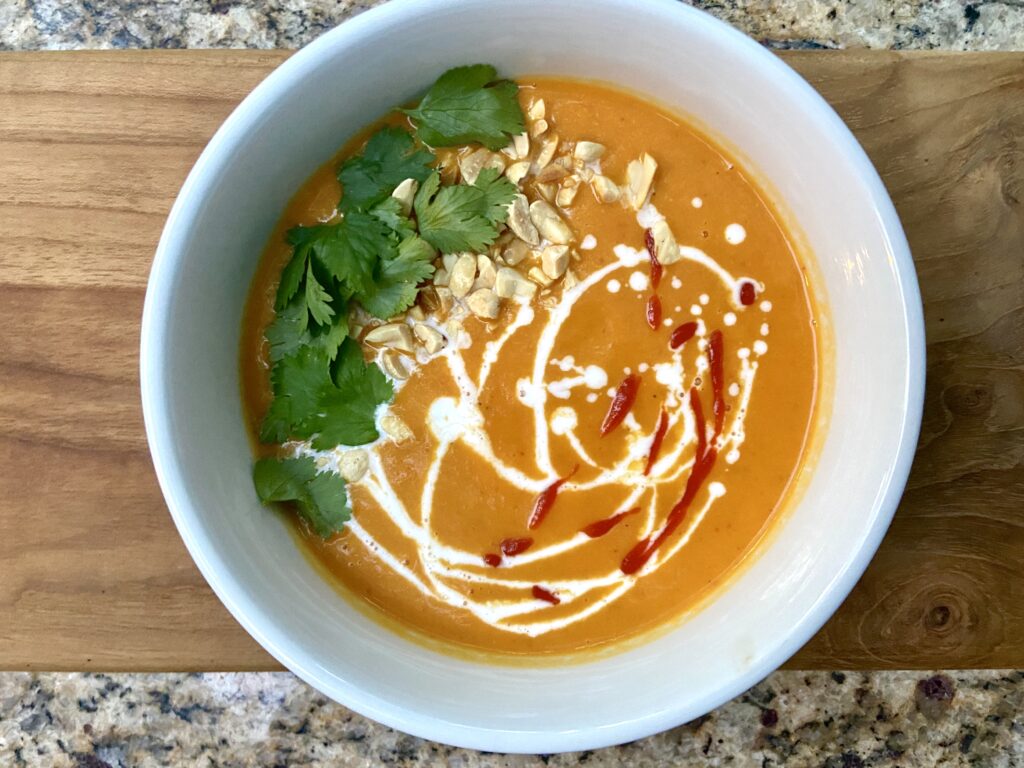
Recipe and Photos by Christina Hurt Smith.
I’m sure this has happened once or twice: you get your new CSA box, it comes with a huge bag of carrots but you haven’t yet finished your last huge bag of carrots. This is the very best way to use a bunch of carrots at once. This soup can also be prepared vegan if you leave out the fish sauce and use vegetable broth instead of chicken broth. One important thing: I have listed a specific brand for the red curry paste for a reason. Maesri curry paste is truly the best and can be found in most asian markets. Sure you could use another brand but I promise you, once you taste this you will never go back. With that said, if you are unable to find it, it’s not a deal-breaker. Your soup will be delicious anyway. Enjoy!
Curried Carrot and Sweet Potato Soup
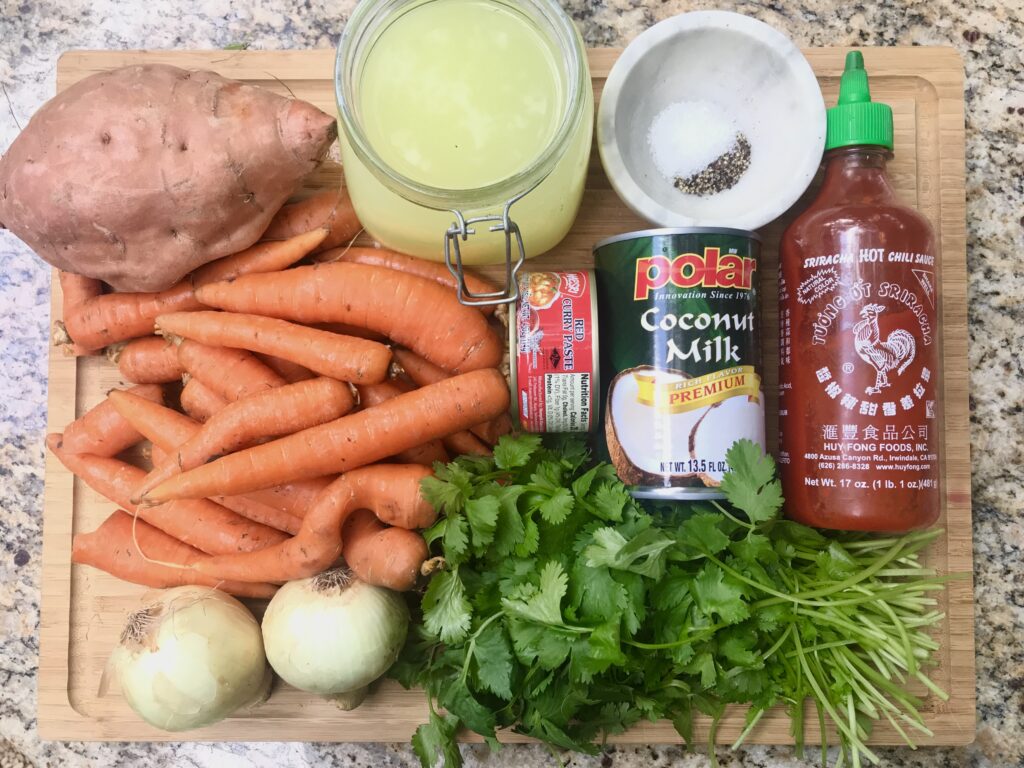
Ingredients:
- 1lb Carrots, peeled and chopped into 1in chunks
- 1 Sweet Potato, peeled and chopped into 1in chunks
- 1 Large Onion (or 2 small), diced
- 1 can (13.5oz) Coconut Milk, full fat
- 1 can (4oz) Maesri Red Curry Paste
- 3c Vegetable or Chicken Broth
- 2 tbsp Butter or Coconut Milk
- 1 tbsp Fish Sauce (optional)
- 1 tbsp Sugar
- Salt
- Pepper
- Garnish:
- Cilantro
- Toasted Peanuts
- Sriracha

Directions:
1. Heat a large pot to medium-high heat. Add butter or oil and toss in onion. Cook for 3 minutes until onion is translucent.
2. Add in red curry and coat the onions. Cook for 1 minute.
3. Toss in carrot and sweet potato chunks and stir to coat in onion and curry mixture. Cook for 5 minutes.
4. Add in broth. Place your lid on the pot and bring to boil. Once the mixture comes to a boil, turn heat to low and cook for 30 minutes or until the carrots and sweet potato are soft. Remove from heat.
5. Add sugar, fish sauce and can of coconut milk, reserving a little to garnish.
6. You can either use a hand emulsifier or you can let the mixture cool and blend in batches. Salt and pepper to taste.
7. Ladle soup into bowls and garnish with drizzle or reserved coconut milk, sriracha, toasted peanuts and cilantro.
PHOTOS FROM THE FARM: 7.3.2020
07/03/20 — Ada Broussard
Last week, Scott's trip to the farm got rained out. This week, the vegetables were really showing off for Scott - sporting electric colors seemingly fueled by recent rains and scorching heat.
![]() Wearing gloves to harvest vegetables is standard food safety policy at the farm. When picking hot peppers, they give the added benefit of spice protection! Photo by Scott David Gordon.
Wearing gloves to harvest vegetables is standard food safety policy at the farm. When picking hot peppers, they give the added benefit of spice protection! Photo by Scott David Gordon.
![]() Melon mania has begun! Just in time for these 100 degree days. Photo by Scott David Gordon.
Melon mania has begun! Just in time for these 100 degree days. Photo by Scott David Gordon.
![]() Jack making sense of greenhouse inventory. Photo by Scott David Gordon.
Jack making sense of greenhouse inventory. Photo by Scott David Gordon.
![]() The perfect partner for a cold watermelon. Photo by Scott David Gordon.
The perfect partner for a cold watermelon. Photo by Scott David Gordon.
![]() Freshly harvested dandelion greens in the protective shade of our delivery-turn-harvest van. Photo by Scott David Gordon.
Freshly harvested dandelion greens in the protective shade of our delivery-turn-harvest van. Photo by Scott David Gordon.
![]() A tropical plant, okra was brought to America via the transatlantic slave trade. Photo by Scott David Gordon.
A tropical plant, okra was brought to America via the transatlantic slave trade. Photo by Scott David Gordon.
![]() One of our favorite fried okra recipes is up on the blog. How do you fry your okra? Photo by Scott David Gordon.
One of our favorite fried okra recipes is up on the blog. How do you fry your okra? Photo by Scott David Gordon.
![]() A mess of tendrils. Photo by Scott David Gordon.
A mess of tendrils. Photo by Scott David Gordon.
![]() A withered once-was-flower attached to a ridged pattypan squash. Photo by Scott David Gordon.
A withered once-was-flower attached to a ridged pattypan squash. Photo by Scott David Gordon.
![]() We usually plant rows of basil in between 7-8 rows of tomatoes, and harvesting basil is a breezy reprieve from standing in the towering tomatoes. Photo by Scott David Gordon.
We usually plant rows of basil in between 7-8 rows of tomatoes, and harvesting basil is a breezy reprieve from standing in the towering tomatoes. Photo by Scott David Gordon.
![]() Did you know that jalapenos will ripen to red? Red jalapenos spend more time ripening on the vine and have more time to develop capsaicin - the chemical that gives a pepper its spice. Hence, red jalapenos pack more of a punch than younger green ones. Photo by Scott David Gordon.
Did you know that jalapenos will ripen to red? Red jalapenos spend more time ripening on the vine and have more time to develop capsaicin - the chemical that gives a pepper its spice. Hence, red jalapenos pack more of a punch than younger green ones. Photo by Scott David Gordon.
![]() This summer we trialed a new variety of jalapenos that are bigger! Can you believe the size on these peppers? It certainly makes for easier picking. Photo by Scott David Gordon.
This summer we trialed a new variety of jalapenos that are bigger! Can you believe the size on these peppers? It certainly makes for easier picking. Photo by Scott David Gordon.
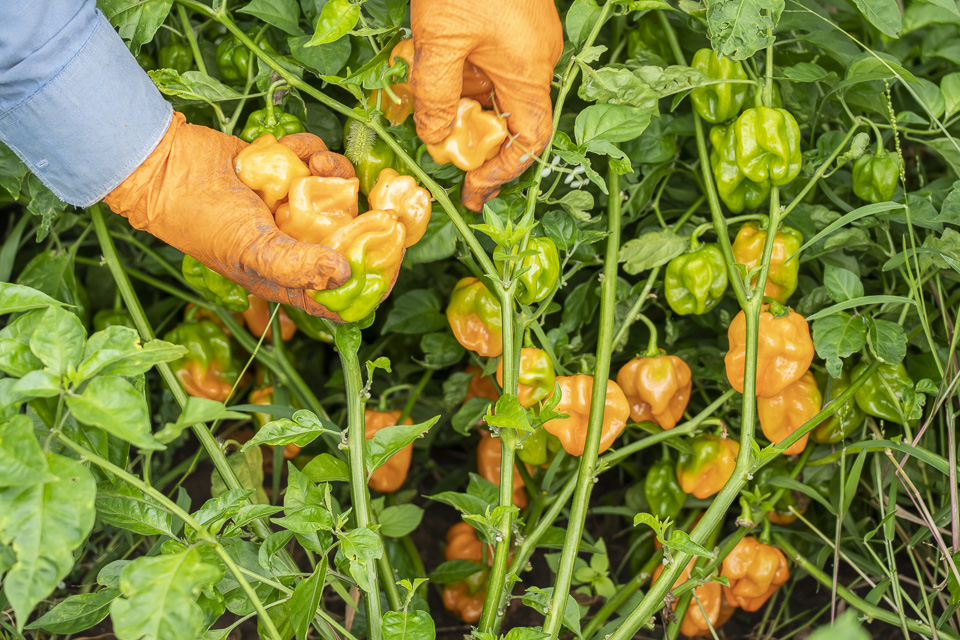 Wearing gloves to harvest vegetables is standard food safety policy at the farm. When picking hot peppers, they give the added benefit of spice protection! Photo by Scott David Gordon.
Wearing gloves to harvest vegetables is standard food safety policy at the farm. When picking hot peppers, they give the added benefit of spice protection! Photo by Scott David Gordon.
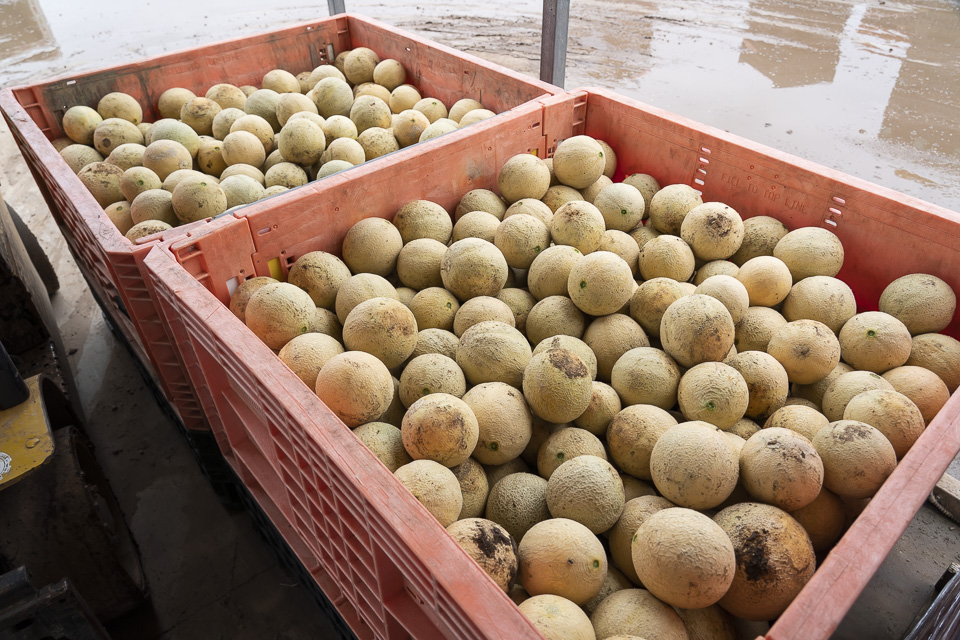 Melon mania has begun! Just in time for these 100 degree days. Photo by Scott David Gordon.
Melon mania has begun! Just in time for these 100 degree days. Photo by Scott David Gordon.
 Jack making sense of greenhouse inventory. Photo by Scott David Gordon.
Jack making sense of greenhouse inventory. Photo by Scott David Gordon.
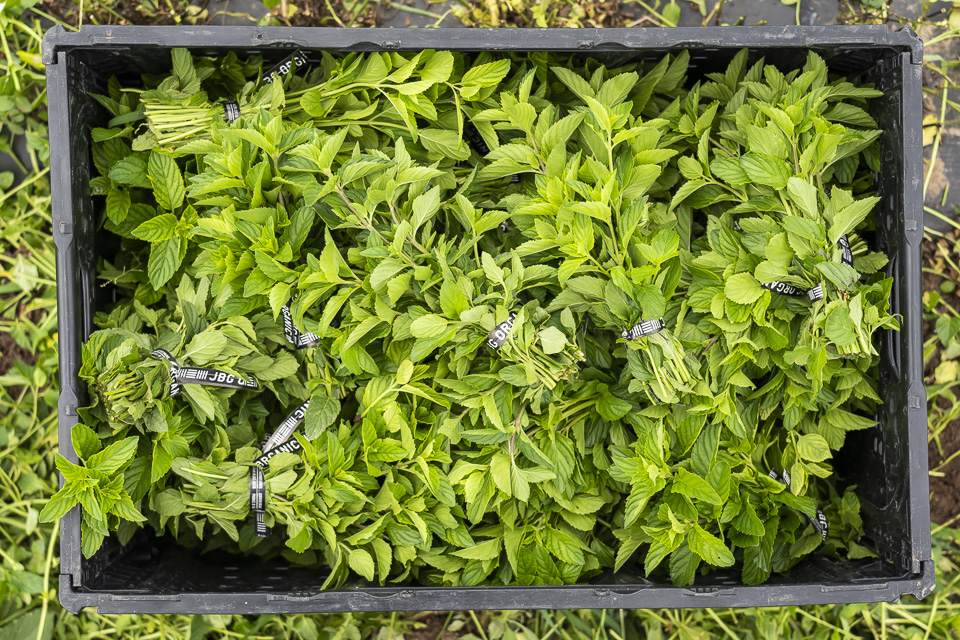 The perfect partner for a cold watermelon. Photo by Scott David Gordon.
The perfect partner for a cold watermelon. Photo by Scott David Gordon.
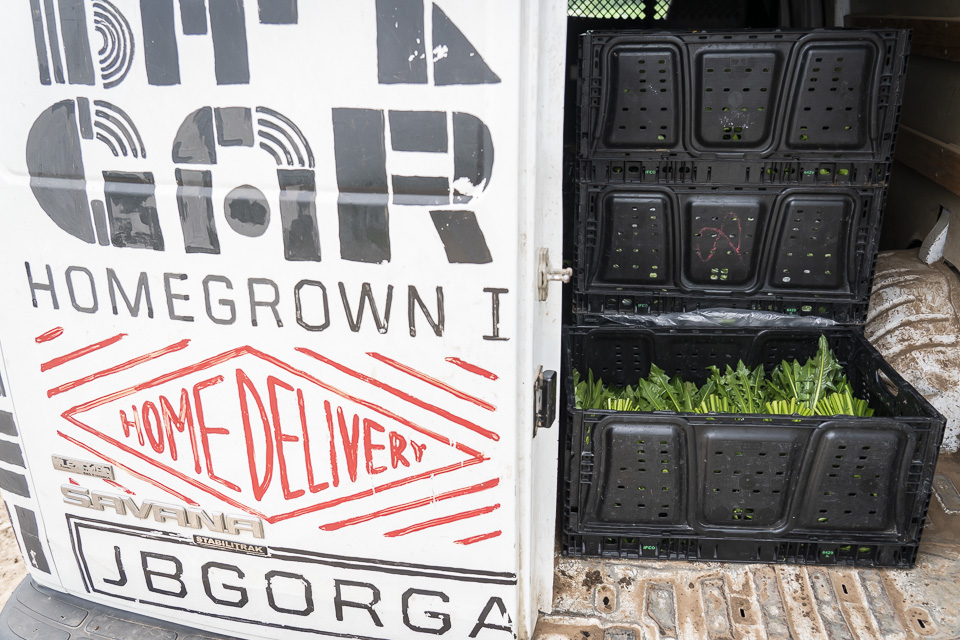 Freshly harvested dandelion greens in the protective shade of our delivery-turn-harvest van. Photo by Scott David Gordon.
Freshly harvested dandelion greens in the protective shade of our delivery-turn-harvest van. Photo by Scott David Gordon.
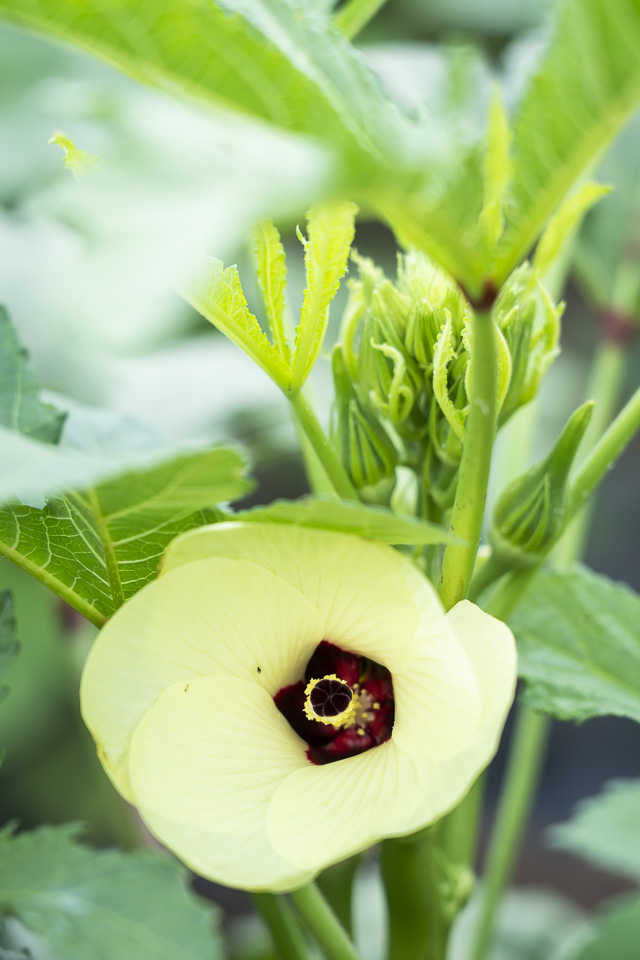 A tropical plant, okra was brought to America via the transatlantic slave trade. Photo by Scott David Gordon.
A tropical plant, okra was brought to America via the transatlantic slave trade. Photo by Scott David Gordon.
 One of our favorite fried okra recipes is up on the blog. How do you fry your okra? Photo by Scott David Gordon.
One of our favorite fried okra recipes is up on the blog. How do you fry your okra? Photo by Scott David Gordon.
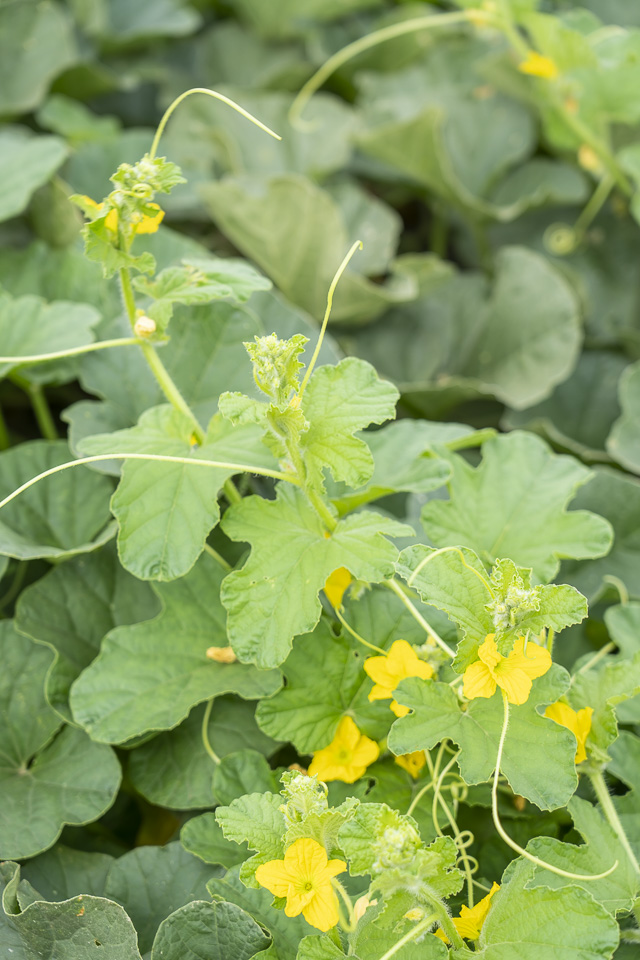 A mess of tendrils. Photo by Scott David Gordon.
A mess of tendrils. Photo by Scott David Gordon.
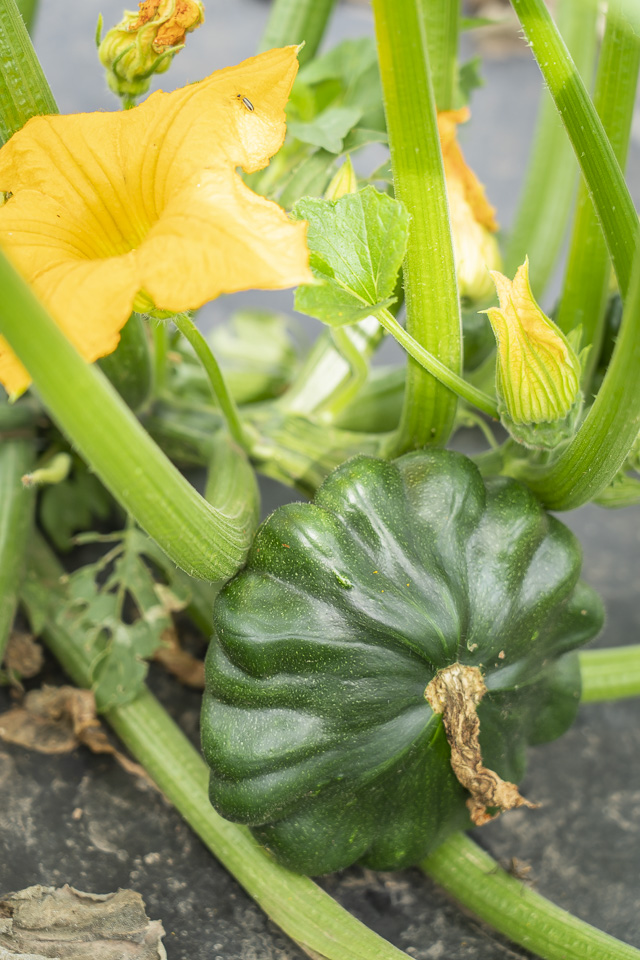 A withered once-was-flower attached to a ridged pattypan squash. Photo by Scott David Gordon.
A withered once-was-flower attached to a ridged pattypan squash. Photo by Scott David Gordon.
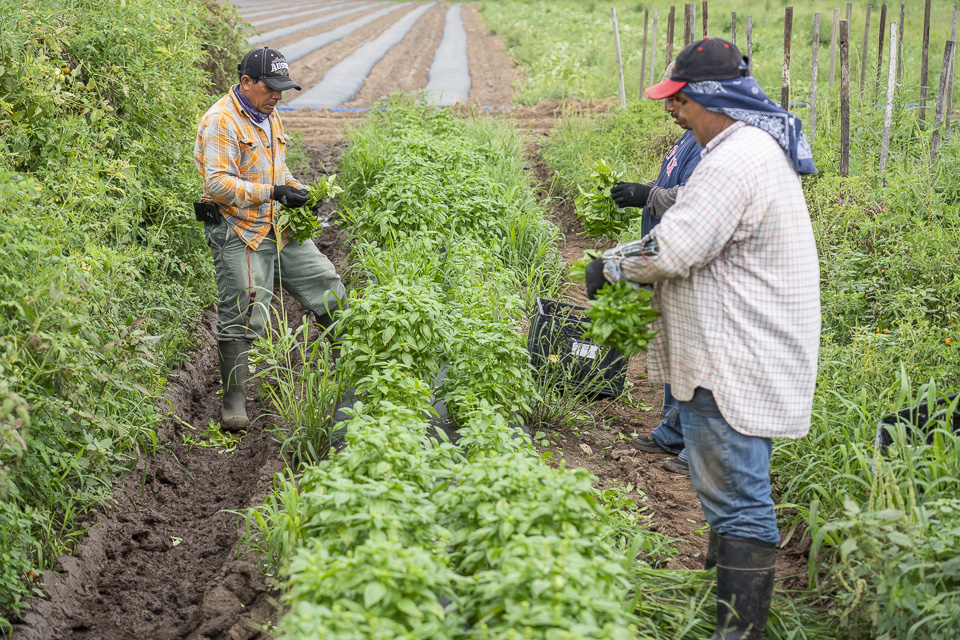 We usually plant rows of basil in between 7-8 rows of tomatoes, and harvesting basil is a breezy reprieve from standing in the towering tomatoes. Photo by Scott David Gordon.
We usually plant rows of basil in between 7-8 rows of tomatoes, and harvesting basil is a breezy reprieve from standing in the towering tomatoes. Photo by Scott David Gordon.
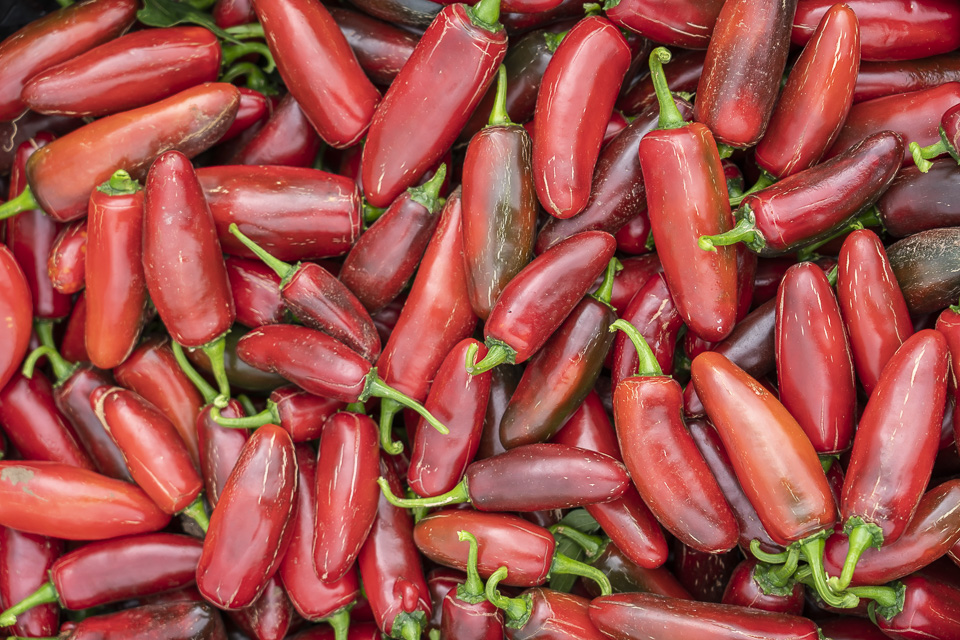 Did you know that jalapenos will ripen to red? Red jalapenos spend more time ripening on the vine and have more time to develop capsaicin - the chemical that gives a pepper its spice. Hence, red jalapenos pack more of a punch than younger green ones. Photo by Scott David Gordon.
Did you know that jalapenos will ripen to red? Red jalapenos spend more time ripening on the vine and have more time to develop capsaicin - the chemical that gives a pepper its spice. Hence, red jalapenos pack more of a punch than younger green ones. Photo by Scott David Gordon.
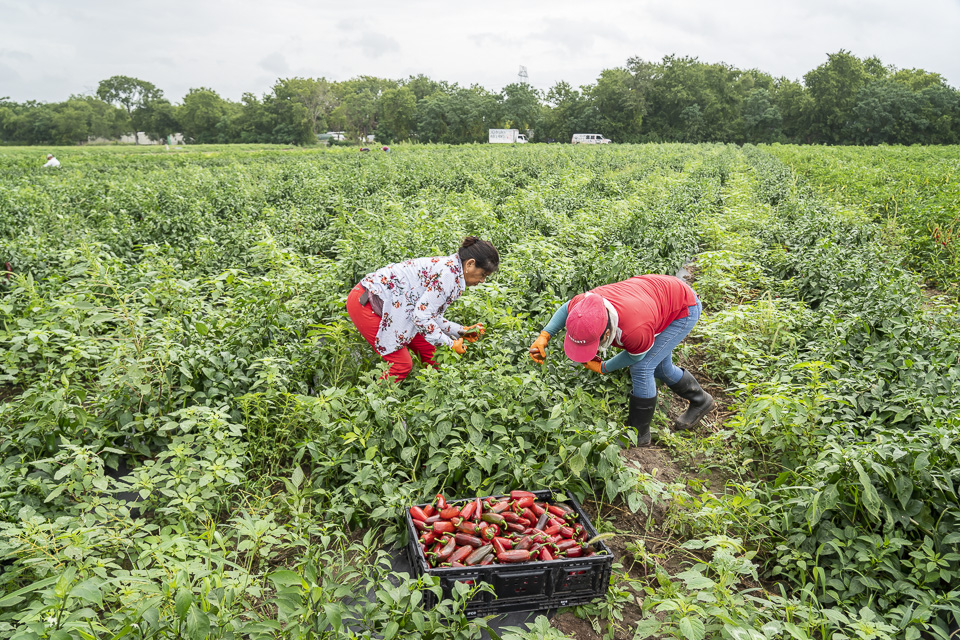 This summer we trialed a new variety of jalapenos that are bigger! Can you believe the size on these peppers? It certainly makes for easier picking. Photo by Scott David Gordon.
This summer we trialed a new variety of jalapenos that are bigger! Can you believe the size on these peppers? It certainly makes for easier picking. Photo by Scott David Gordon.WHAT TO COOK (AND REMEMBER) THIS FOURTH OF JULY
07/03/20 — Ada Broussard
This July 4th is one that we will all likely remember. You’re likely spending the day with a small group, maybe even just your immediate family or chosen quaranteam. Austin parks are closed, bars shuddered, and many parties canceled. But, you’ve still got to eat, no? Our vegetables certainly are still growing, and despite the circumstances of this year’s Independence Day, they beg to be piled high on platters and maybe thrown on the grill.
To keep your weekend simple, we’re going to go ahead and suggest some side dishes for you. What better day to acknowledge this holiday than with dishes that help us remember our country’s past, and look forward with hope and motivation for its future?
This July 4th, cook the summer classics: Squash, Okra, Tomates, and Watermelon.
![]() Who needs a blueberry pie when you can make a tomato one? Photo by Rick Cortez.
Who needs a blueberry pie when you can make a tomato one? Photo by Rick Cortez.
SQUASH: Squash, along with beans and corn, was one of the earliest domesticated crops in the Americas. The three crops together are known as the Three Sisters, but it’s noteworthy that the consumption and domestication of squash likely came first! The earliest evidence of squash cultivation in what is now the United States ranges from 5,000-8,000 years ago, beginning on the east coast but then eventually spreading far and wide across North America making squash (and gourds and pumpkins) an important staple food for indigenous peoples all across the Americas. Squash is easy to germinate and grows effortlessly. It’s deep roots in North America no doubt make it an obvious choice for a summer celebration.
How to enjoy squash this year: Grill your squash over a hot fire, and top with basil: either finely chopped, blended into a pesto, or infused into oil. This Smitten Kitchen recipe is a wonderful starting point. For a heartier dish, she adds white beans and makes a grilled squash and pesto bean salad.
![]() Photo taken from the Smitten Kitchen website. Recipe linked!
Photo taken from the Smitten Kitchen website. Recipe linked!
OKRA Okra arrived in the United States with enslaved West Africans, brought to the new world as food for enslaved people to eat along the passage. Once landed, many of the enslaved planted and cultivated okra in small gardens as a means to supplement the meager rations provided by slave owners. Okra, therefore, became an important source of sustenance, as well as culinary tradition, for many slaves in the Southern United States. Like history itself, the use and popularity of okra expanded and evolved with time. The tropical plant grows well in hot summers and has become a cornerstone of Southern food traditions. Prepare your okra with a healthy dose of introspection and celebration of Black cooking traditions and its impact on Southern foodways.
How to enjoy okra this year: Fry it, of course! Here is one of our favorite fried okra recipes by Tanorria Askew. Tanorria takes her grandmother’s fried okra recipe and adds her Master Chef touch.
![]() Fried okra recipe and photo courtesy of Tannori Askew's Instagram.
Fried okra recipe and photo courtesy of Tannori Askew's Instagram.
TOMATOES Tomato plants are actually native to Central America, and before domestication, the tomato plant grew like wild vines in these tropical regions bearing tiny and very acidic fruit. The Aztec people consumed the tiny fruit for centuries. When Europeans encountered tomatoes in the Americas, they brought the fruit and see back home. Interestingly, many Europeans feared the tomato and considered it poisonous (even nicknaming in the “poison apple” for hundreds of years. Many Europeans were eating on pewter plates and pewter flatware which contained high amounts of lead. Because of tomatoes’ acidity, the fruit would leach lead from the plates, often killing the diners. Of course, those eating off of wooden plates with wooden wares didn’t experience this problem, and tomatoes slowly and surly became a beloved fruit of poorer families, specifically in parts of Spain as well as in Naples, Italy, where pizza was born. The skepticism of the tomatoes carried over to European colonists, though there were rural gardeners who embraced the fruit. It wasn’t until the Civil War that the tomato because a commonplace vegetable. Tomato canneries boomed during this period, and tomatoes’ ability to be preserved this way made them a staple food for the Union army. Enjoy a tomato this holiday, and honor the battles we have faced, and continue to face, to achieve the American ideal.
How to enjoy tomatoes this year: Make a pie. Sure, blueberry pie and peach cobbler are traditional 4th of July foods. But why not make a savory, tomato pie? Here is our favorite tomato pie recipe and here is a tomato galette (or rustic pie) recipe, both from the JBG archives. (P.S. We just counted, and this year we have sold 18,000 lbs. of tomatoes through our Bulk Sale! We still have slicer and cherry tomato varieties available, but the sale will end soon. Order here if you want tomato pies for days!)
![]() Tomato pie crust. Recipe linked above. Photo by Megan Russel.
Tomato pie crust. Recipe linked above. Photo by Megan Russel.
WATERMELON The average high temperature in Austin on the 4th of July is 95 degrees. Each bite of a watermelon is about 91% water (and 6% sugar). Is there any better fruit to enjoy on the Fourth of July? Unfortunately, the enjoyment of a watermelon isn’t as straightforward of delight for Black Americas because the fruit has long been used as a racist trope. This Atlantic article tells the story, “...the stereotype that African Americans are excessively fond of watermelon emerged for a specific historical reason and served a specific political purpose. The trope came in full force when slaves won their emancipation during the Civil War. Free black people grew, ate, and sold watermelons, and in doing so made the fruit a symbol of their freedom. Southern whites, threatened by blacks’ newfound freedom, responded by making the fruit a symbol of black people’s perceived uncleanliness, laziness, childishness, and unwanted public presence.”
This Atlantic article tells the full story better than we can, and we encourage you all to give the complete article a read. We don’t point out this complicated facet of watermelon to dissuade you from slicing one up, and in fact, we hope we’re able to do the opposite! Let this sweet and hydrating fruit nourish us this summer and help invigorate our collective desire to create a better country tomorrow that exists today.
How to enjoy watermelon this year: Sliced, with our without salt.
As always, thank you for reading and thank you for being such a wonderful community for us to farm in. Your support makes the 100 degree days worth it!
![]() Watermelons waiting in the field. Photo by Scott David Gordon.
Watermelons waiting in the field. Photo by Scott David Gordon.
To keep your weekend simple, we’re going to go ahead and suggest some side dishes for you. What better day to acknowledge this holiday than with dishes that help us remember our country’s past, and look forward with hope and motivation for its future?
This July 4th, cook the summer classics: Squash, Okra, Tomates, and Watermelon.
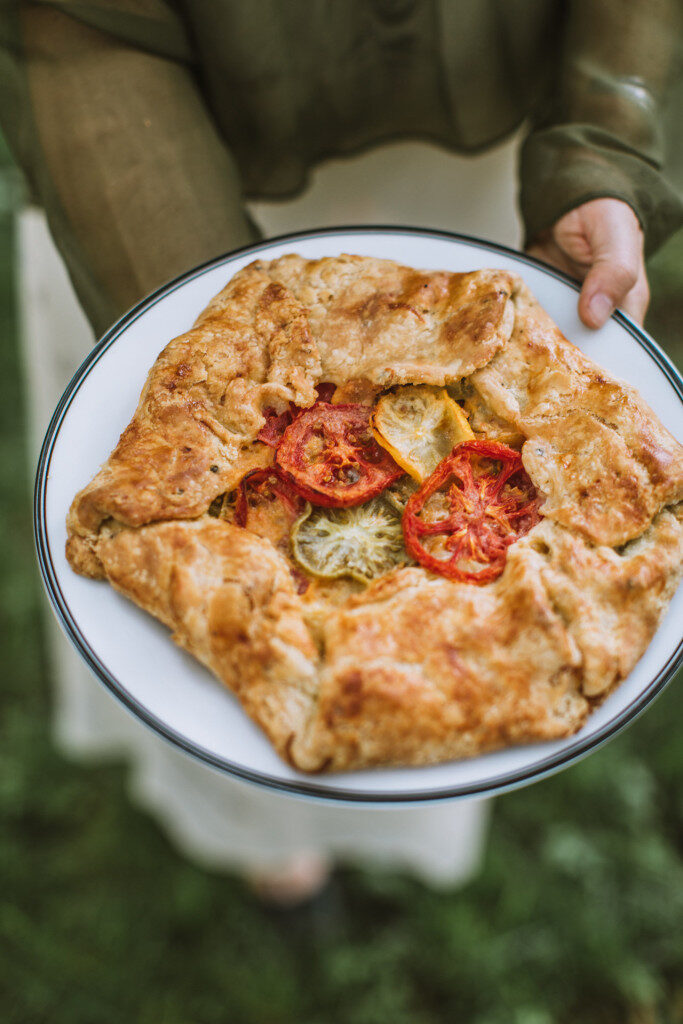 Who needs a blueberry pie when you can make a tomato one? Photo by Rick Cortez.
Who needs a blueberry pie when you can make a tomato one? Photo by Rick Cortez.
SQUASH: Squash, along with beans and corn, was one of the earliest domesticated crops in the Americas. The three crops together are known as the Three Sisters, but it’s noteworthy that the consumption and domestication of squash likely came first! The earliest evidence of squash cultivation in what is now the United States ranges from 5,000-8,000 years ago, beginning on the east coast but then eventually spreading far and wide across North America making squash (and gourds and pumpkins) an important staple food for indigenous peoples all across the Americas. Squash is easy to germinate and grows effortlessly. It’s deep roots in North America no doubt make it an obvious choice for a summer celebration.
How to enjoy squash this year: Grill your squash over a hot fire, and top with basil: either finely chopped, blended into a pesto, or infused into oil. This Smitten Kitchen recipe is a wonderful starting point. For a heartier dish, she adds white beans and makes a grilled squash and pesto bean salad.
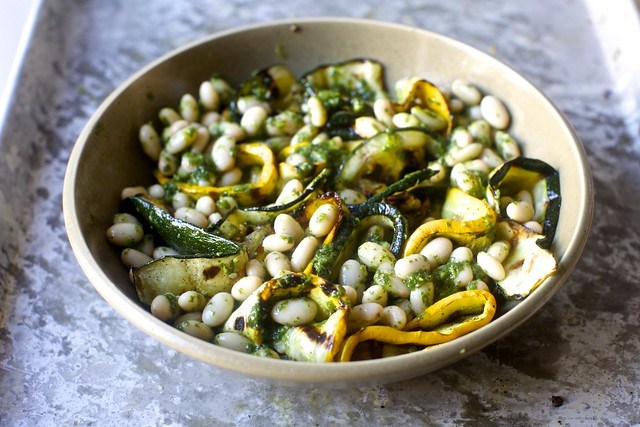 Photo taken from the Smitten Kitchen website. Recipe linked!
Photo taken from the Smitten Kitchen website. Recipe linked!
OKRA Okra arrived in the United States with enslaved West Africans, brought to the new world as food for enslaved people to eat along the passage. Once landed, many of the enslaved planted and cultivated okra in small gardens as a means to supplement the meager rations provided by slave owners. Okra, therefore, became an important source of sustenance, as well as culinary tradition, for many slaves in the Southern United States. Like history itself, the use and popularity of okra expanded and evolved with time. The tropical plant grows well in hot summers and has become a cornerstone of Southern food traditions. Prepare your okra with a healthy dose of introspection and celebration of Black cooking traditions and its impact on Southern foodways.
How to enjoy okra this year: Fry it, of course! Here is one of our favorite fried okra recipes by Tanorria Askew. Tanorria takes her grandmother’s fried okra recipe and adds her Master Chef touch.
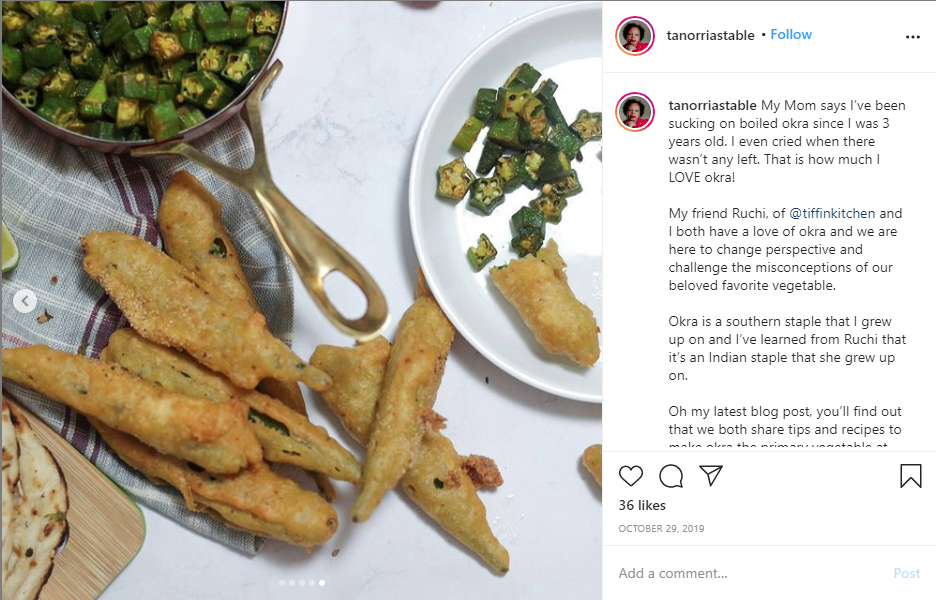 Fried okra recipe and photo courtesy of Tannori Askew's Instagram.
Fried okra recipe and photo courtesy of Tannori Askew's Instagram.
TOMATOES Tomato plants are actually native to Central America, and before domestication, the tomato plant grew like wild vines in these tropical regions bearing tiny and very acidic fruit. The Aztec people consumed the tiny fruit for centuries. When Europeans encountered tomatoes in the Americas, they brought the fruit and see back home. Interestingly, many Europeans feared the tomato and considered it poisonous (even nicknaming in the “poison apple” for hundreds of years. Many Europeans were eating on pewter plates and pewter flatware which contained high amounts of lead. Because of tomatoes’ acidity, the fruit would leach lead from the plates, often killing the diners. Of course, those eating off of wooden plates with wooden wares didn’t experience this problem, and tomatoes slowly and surly became a beloved fruit of poorer families, specifically in parts of Spain as well as in Naples, Italy, where pizza was born. The skepticism of the tomatoes carried over to European colonists, though there were rural gardeners who embraced the fruit. It wasn’t until the Civil War that the tomato because a commonplace vegetable. Tomato canneries boomed during this period, and tomatoes’ ability to be preserved this way made them a staple food for the Union army. Enjoy a tomato this holiday, and honor the battles we have faced, and continue to face, to achieve the American ideal.
How to enjoy tomatoes this year: Make a pie. Sure, blueberry pie and peach cobbler are traditional 4th of July foods. But why not make a savory, tomato pie? Here is our favorite tomato pie recipe and here is a tomato galette (or rustic pie) recipe, both from the JBG archives. (P.S. We just counted, and this year we have sold 18,000 lbs. of tomatoes through our Bulk Sale! We still have slicer and cherry tomato varieties available, but the sale will end soon. Order here if you want tomato pies for days!)
 Tomato pie crust. Recipe linked above. Photo by Megan Russel.
Tomato pie crust. Recipe linked above. Photo by Megan Russel.
WATERMELON The average high temperature in Austin on the 4th of July is 95 degrees. Each bite of a watermelon is about 91% water (and 6% sugar). Is there any better fruit to enjoy on the Fourth of July? Unfortunately, the enjoyment of a watermelon isn’t as straightforward of delight for Black Americas because the fruit has long been used as a racist trope. This Atlantic article tells the story, “...the stereotype that African Americans are excessively fond of watermelon emerged for a specific historical reason and served a specific political purpose. The trope came in full force when slaves won their emancipation during the Civil War. Free black people grew, ate, and sold watermelons, and in doing so made the fruit a symbol of their freedom. Southern whites, threatened by blacks’ newfound freedom, responded by making the fruit a symbol of black people’s perceived uncleanliness, laziness, childishness, and unwanted public presence.”
This Atlantic article tells the full story better than we can, and we encourage you all to give the complete article a read. We don’t point out this complicated facet of watermelon to dissuade you from slicing one up, and in fact, we hope we’re able to do the opposite! Let this sweet and hydrating fruit nourish us this summer and help invigorate our collective desire to create a better country tomorrow that exists today.
How to enjoy watermelon this year: Sliced, with our without salt.
As always, thank you for reading and thank you for being such a wonderful community for us to farm in. Your support makes the 100 degree days worth it!
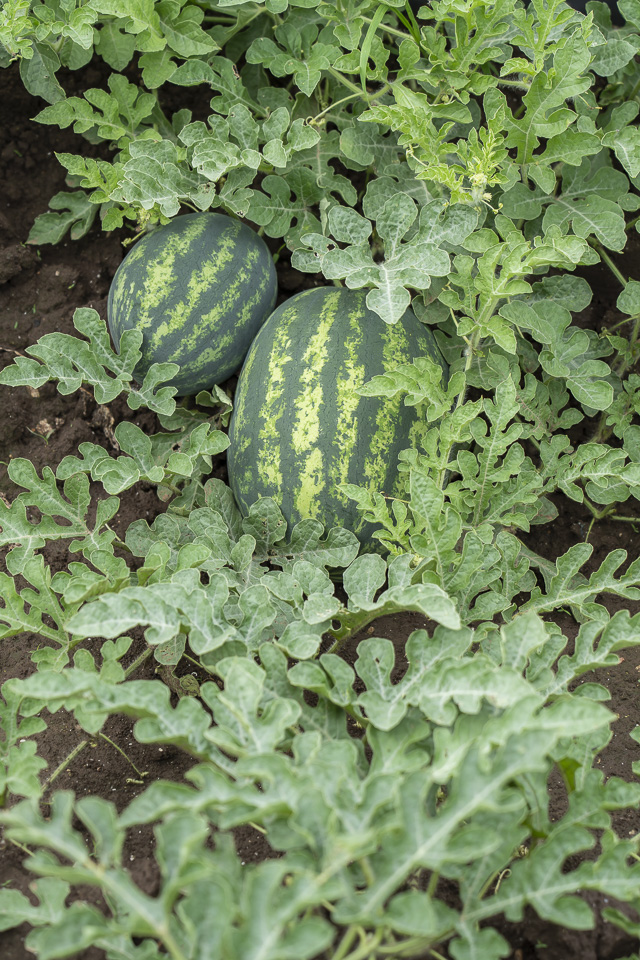 Watermelons waiting in the field. Photo by Scott David Gordon.
Watermelons waiting in the field. Photo by Scott David Gordon.CSA BOX CONTENTS WEEK OF JULY 6TH
07/06/20 — Scott
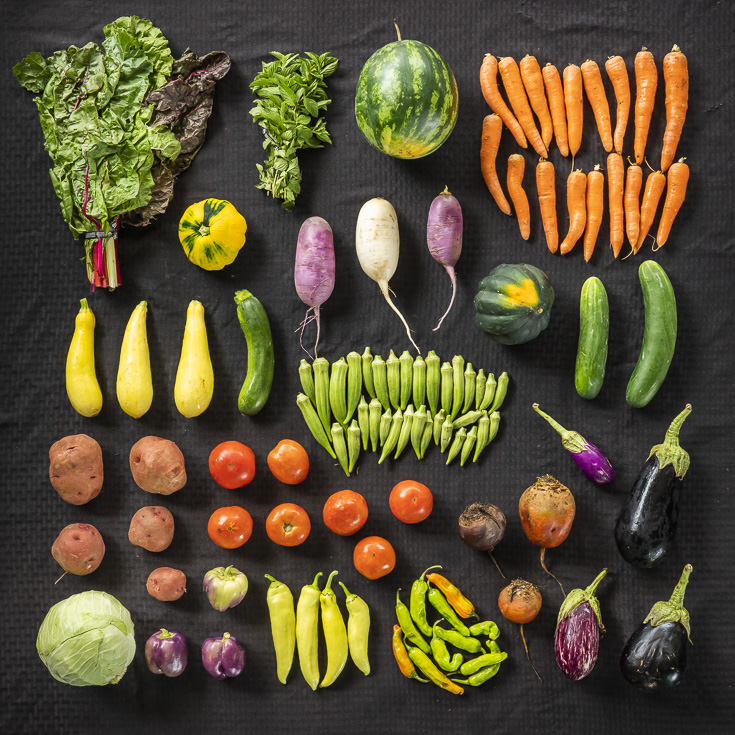 CSA Box Contents Week of July 6th
CSA Box Contents Week of July 6th
Large Box
Beets
Cucumber
Herb, Farmers Choice
Melon, Farmers Choice
Pepper, Hot Medley
Pepper, Shishito
Pepper, Sweet
Potato
Squash, Farmer's Choice
Tomato
Winter Squash
Beets
Cucumber
Herb, Farmers Choice
Melon, Farmers Choice
Pepper, Hot Medley
Pepper, Shishito
Pepper, Sweet
Potato
Squash, Farmer's Choice
Tomato
Winter Squash
Medium Box
Cucumber
Eggplant
Herb, Farmers Choice
Okra
Pepper, Hot Medley
Pepper, Sweet
Potato
Squash, Farmer's Choice
Winter Squash
Cucumber
Eggplant
Herb, Farmers Choice
Okra
Pepper, Hot Medley
Pepper, Sweet
Potato
Squash, Farmer's Choice
Winter Squash
Small Box
Beets
Cucumber
Eggplant
Herb, Farmers Choice
Pepper, Sweet
Potato
Squash, Farmer's Choice
Beets
Cucumber
Eggplant
Herb, Farmers Choice
Pepper, Sweet
Potato
Squash, Farmer's Choice
Individual Box
Beets
Cucumber
Okra
Pepper, Sweet
Potato
Beets
Cucumber
Okra
Pepper, Sweet
Potato
CSA BOX CONTENTS WEEK OF JULY 6TH
07/07/20 — Scott
 CSA Box Contents Week of July 6th
CSA Box Contents Week of July 6th
Large Box
Beets
Cabbage
Eggplant
Greens, Chard, Rainbow
Herb, Farmers Choice
Melon, Farmers Choice
Okra
Pepper, Sweet
Potato
Radish
Squash, Farmer's Choice
Tomato
SPICY, HERBY BUTTER LETTUCE DELIGHT
07/08/20 — Ada Broussard
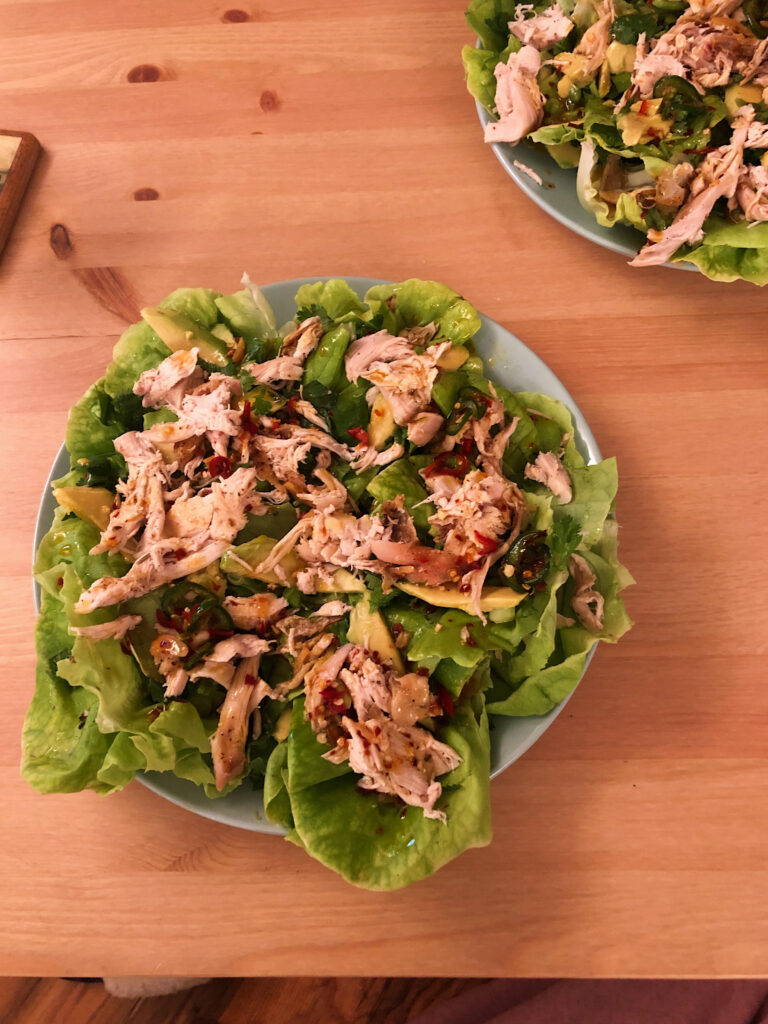
Spicy, Herby Butter Lettuce Delight
By Isaac and Heydon
This salad is amazing. Lately, it’s all I’ve been craving. One night a couple weeks ago, Isaac threw this together when I asked for more “green in my life”. It’s the perfect blend of spicy and fresh. It fills you up but simultaneously feels super light. The recipe we have listed below for the sauce is a loose guide. If you don’t have all the ingredients or want to take it in another direction, more power to you. It should be fun and easy but more importantly, totally delicious.
Sauce Ingredients
- 1 half cup of Olive oil
- 3 to 4 tablespoons of Sesame oil
- 1 to 2 tablespoons of Soy sauce
- 1 to 2 tablespoons of Ponzu sauce
- 1 teaspoon of Fish sauce
- 1 to 2 tablespoons of Worcestershire sauce
- 3 to 4 tablespoons of Rice vinegar
- 1 tablespoon of honey
- The juice of half a lime
- 3 cloves of garlic, minced
- 1/4 cup of toasted cashews, chopped roughly
- ** salt to taste (there is already loads of sodium from the sauces above)
Salad Ingredients
- 2 jalapeños, very thinly sliced
- 4 green onions, thinly sliced
- 1 shallot, finely sliced
- Half a bunch of cilantro, roughly chopped
- 4 to 5 sprigs of mint, roughly chopped
- 2 avocados, sliced medium thin
- 1 head butter lettuce
- 1 rotisserie chicken (regular flavor is ideal)
Combine sauce ingredients and set aside to let flavors meld. Prepare the jalapenos, green onions, shallot, cilantro, and mint, and set aside in a bowl. Slice the avocados, set aside and sprinkle with lime juice and salt. Wash and remove the leaves of the butter lettuce, set aside. Pull about 2 to 3 cups of chicken off of the bird, set aside.
Pour a healthy amount of the sauce in with the pepper and herb mix. Stir lightly, making sure the sauce douses all the ingredients. Place 4 to 5 of the butter lettuce leaves on a plate, and sprinkle pieces of the chicken and avocado over the leaves. Next, spoon the sauced herb and pepper mix over the plated ingredients. Then repeat these two steps, essentially making a two-layer salad. Enjoy!
FIVE FARM RECIPES YOU CAN DRINK
07/10/20 — Ada Broussard
 Perhaps the most adventurous way to drink your veg this summer is this tomato soda. Recipe and photo by Makenzie Smith. Linked below!
Perhaps the most adventurous way to drink your veg this summer is this tomato soda. Recipe and photo by Makenzie Smith. Linked below!
Happy Friday! Three quick reminders before we dive into this week’s main post.
- CSA Members: Did you know that we have a CSA Referral Program? Our CSA Program no longer has a waitlist (wahoo!), and so all of your friends are cordially invited to join in on the veggie-fun! If you a refer a friend to our CSA Program, you get $20 and they get a free box. To refer a friend, simply tell them your referral code. You can find your referral code in the upper right corner of your “My Deliveries” page. When your friend joins the CSA and enters your unique referral code at checkout, you’ll get a $20 credit and they’ll get a free box. Shoot us an email if you have any questions!
- We have three new CSA Pickup Locations that we want you to know about: Texas Blooms and Gifts (in Austin near the Triangle), North Lamar (off of Cannoneer Lane), as well as a new site serving the Hurst, Texas area. If you’re interested in switching your current pickup locations to one of these new sites, just shoot us a message. To see the sites on a map, click here.
- Just a friendly reminder that this veggie storage guide exists. Storing your vegetables properly is most important during these hot summer days. Speaking of…
Have you looked at the forecast for the next week? If not, we hate to be the bearer of bad news, but it’s going to be brutal. We’re talking multiple days mucking through triple-digit temperatures. Many pools are closed, but there are alternatives. Bring back the ice-bucket challenge or do like we do at the farm, and simply spray your friend off with a hose (most can reach 6-feet). You can curbside an inflatable pool, or for the committed among you, invest in a stock tank pool. They’re all the rage this quarantine. This week on the blog, we’re here to suggest 5 sippable recipes that will help get you through this upcoming heatwave. We’re usually in the business of suggesting how to eat our produce, but it just seems right to drink some veg during the hottest days. Staying hydrated will, in fact, help keep your body temperature down.

Some of the recipes below are boozy, and technically, drinking alcohol won’t help to cool you down. If you’re aiming for pure hydration, the three recipes below that contain alcohol would be absolutely delicious without the booze. If your inflatable pool is waiting in the shade and you’re aiming to libate, the two recipes below that do not contain alcohol would be absolutely delicious with the addition of a jig or two. Booze or not, we hope you cheers your way through these hot, hot days. We certainly will!
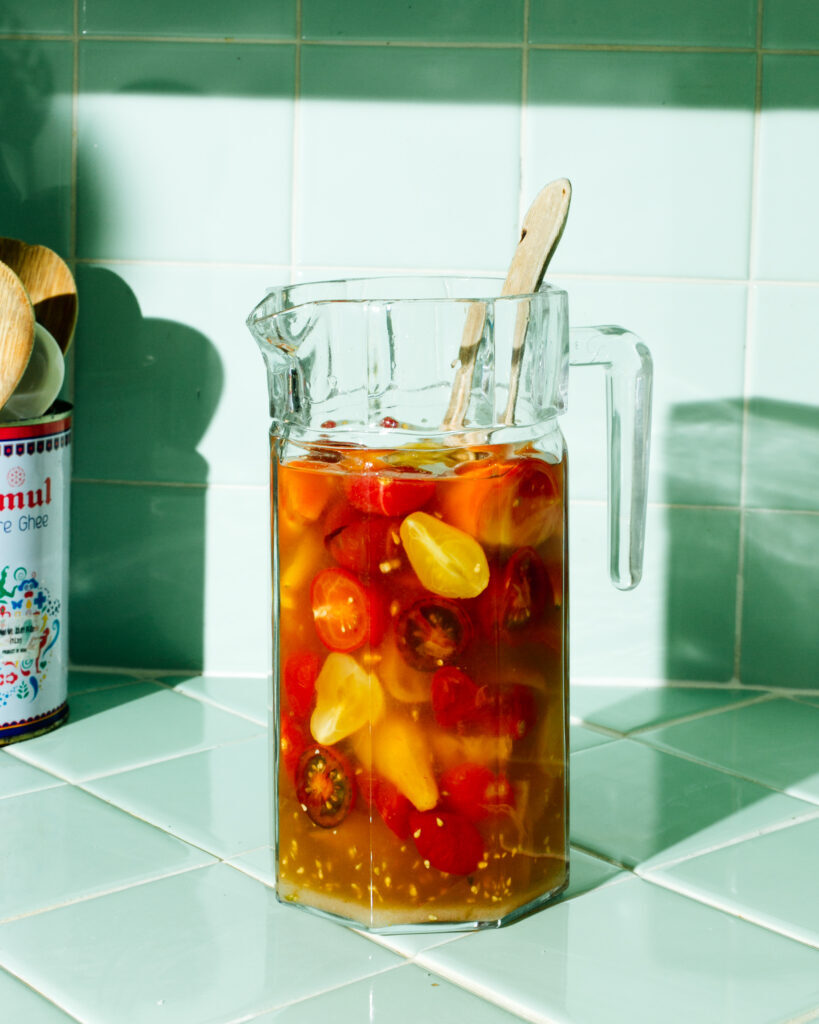 Tomato (or tomato and peach) shurb. You heard it here first, y'all. Tomato soda might just be the next big thing. Recipe and photo by Mackenzie Smith.
Tomato (or tomato and peach) shurb. You heard it here first, y'all. Tomato soda might just be the next big thing. Recipe and photo by Mackenzie Smith.
1. Mackenzie's Tomato Soda
When you grow thousands of pounds of tomatoes every year, you end up eating your fair share of the fruit. As farmers, we thought we had surely tried just about every way there is to enjoy fresh tomatoes, but boy were we wrong. When Mackenzie Smith suggested we make a shrub with tomatoes, our minds were blown. This recipe is such a simple and delicious way to preserve the taste of summer. If you're new to shrubs, this vineargy concoction is often made with fruit and berries, and the resulting sweet and syrupy concoction makes a wonderful addition to a glass of sparkling water.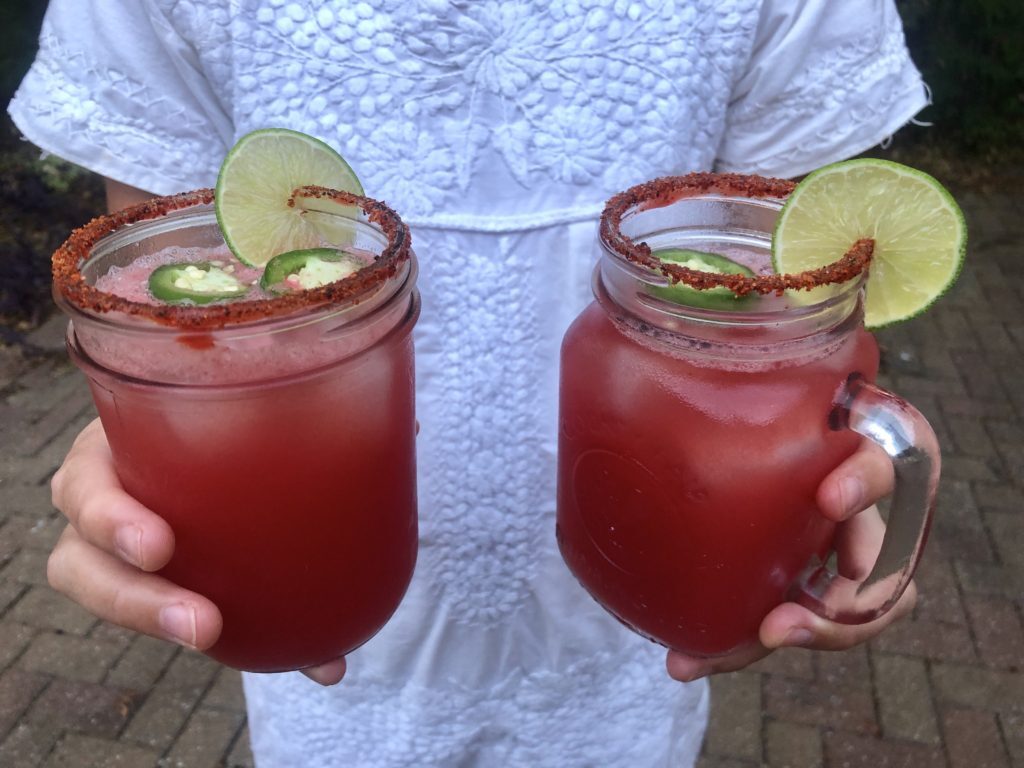 Megan keeps these mason jars in her freezer, margarita ready at all times. Photo courtesy of Meg.
Megan keeps these mason jars in her freezer, margarita ready at all times. Photo courtesy of Meg.
2. Megan's Spicy Watermelon Margarita
At the core of this recipe is the simple technique for making watermelon juice at home. Add tequila (and some spice) and you've got Megan's margarita, but you could also adapt this recipe and simply add mint and cucumber to the watermelon juice for instant hydration. We hope you're not thirsty when you look at this picture because there is something about these giant mason jars full of iced down watermelon juice that really has us hankering for a sip.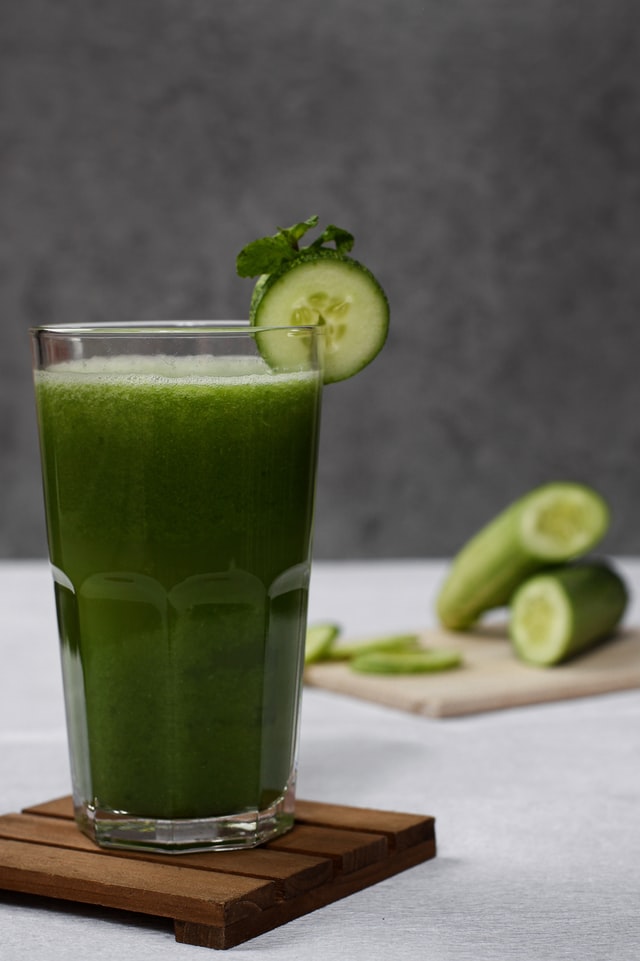
3. Anne's Cool as a Cucumber Juice
Last summer we sat down with local acupuncturist, Anne Woods Miller, to talk about how to beat the heat. In addition to eating more raw foods, Anne also suggested to "add more foods with blue, green, and purple colors to your diet. It's simple, cooling colors cool the body." Scroll to the very end of this blog post for Anne's green summer juice recipe which makes use of cucumbers, mint, and swiss chard... all contents in this week's CSA shares.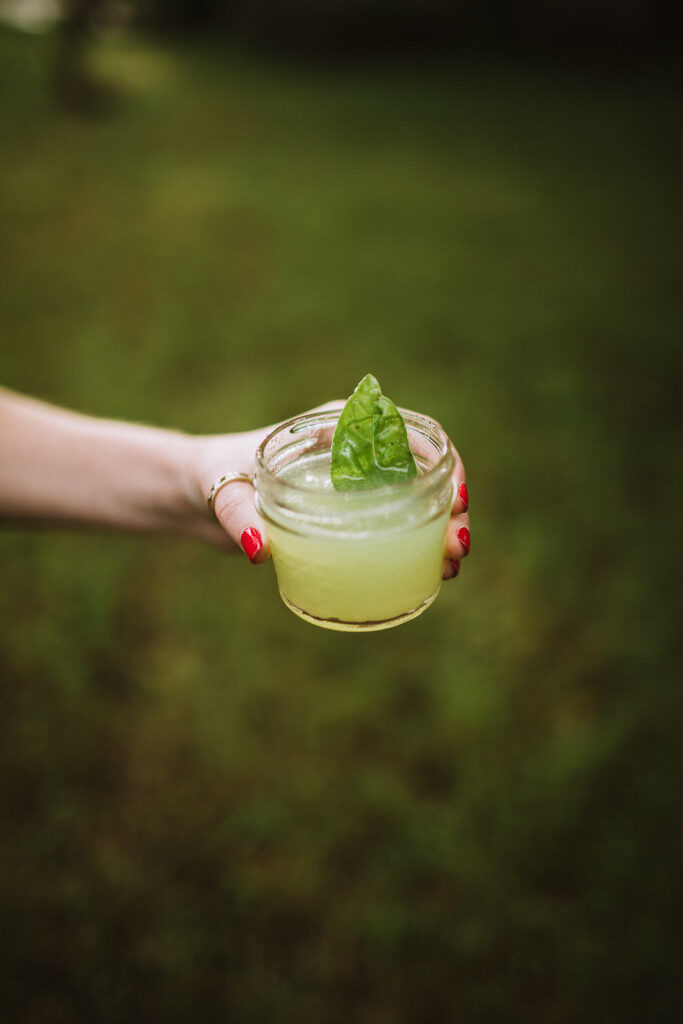 We promise this drink will taste incredible with our without the fire-red nails. Photo by Rick Cortez.
We promise this drink will taste incredible with our without the fire-red nails. Photo by Rick Cortez.
4. Nadia's Honeydew and Green Tomato Gimlet
Wikipedia tells us that a gimlet is "a cocktail typically made of 2 parts gin and 1 part lime juice. A 1928 description of the drink was: gin, and a spot of lime." Nadia's gimlet? She manages to sneak the summer into this classic cocktail, using not one, not two, but three summer classics: honeydew melon, green tomatoes, and basil. Though we're not moving as many green tomatoes at this point in the summer, something tells us Mackenzie's tomato shrub would make a suitable substitution for the green tomato water in this recipe.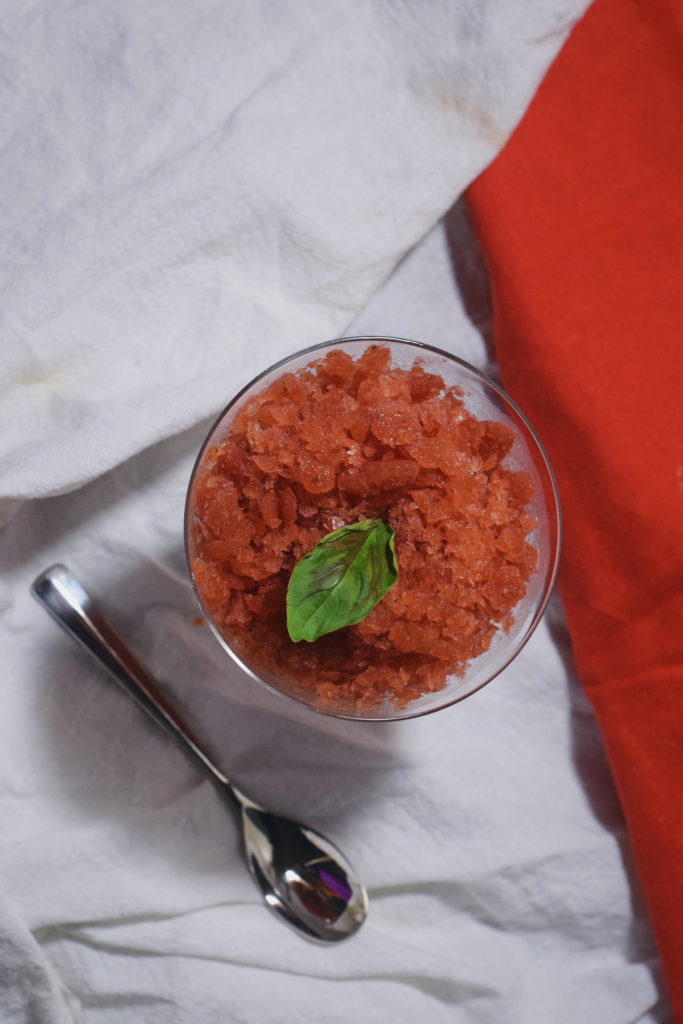
5. Summer's Watermelon, Lime, and Basil Granita
Okay, technically this granita is more easily eaten with a spoon and isn't exactly sippable, but this sorbet-like dessert most certainly deserved a spot in this week's post. "Granita hails from Sicily and is essentially a fancier shaved ice typically made with fresh fruit. You can make granita with any fruit, but we got a perfect mini watermelon + a bunch of fresh basil in our CSA box and this idea was born." Thank you, Summer for embodying your season so well.Bonus Recipe: Krishna's Limeade.
If you're new to the JBG Community, you may not know that our operations manager, Krishna, is an incredible cook. On a very hot day this past October, we spent the day cooking with Krishna. We made huge platters of Indian delicacies for the barn staff to feast on. Many of the recipes featured summer veggies like tomatoes, eggplant, peppers, and potatoes - now is the time to cook this menu if you haven't already! On this day, Krishna introduced us to a simple 4-ingredient drink that is a fresher alternative to Gatorade, perfect for an energizing jolt after a day in the heat. Excerpt from Cooking with Krishna:Lime-ade: The day Krishna and I cooked, it was warm, made warmer by the fact that there was no AC in the farm house we were cooking in. We were hot. After enjoying 1, 2, and then 3 servings of our feast with farm friends, I headed back to the hot kitchen to clean up. Except there was Krishna, drying off the last pot…. Krishna had already cleaned everything. He handed me one of his grandmother’s stainless steel nesting bowls filled with a liquid and said “drink this”. Lime juice, water, salt, and sugar, less diluted than your traditional limeade and leaning more towards “delicious nourishing tonic” than “derby cocktail with straw”.
 Checkout the original Cooking with Krishna post to learn about the sweet story behind this engraved bowl. Photo by Scott David Gordon.
Checkout the original Cooking with Krishna post to learn about the sweet story behind this engraved bowl. Photo by Scott David Gordon.
PHOTOS FROM THE FARM: 7.10.20
07/10/20 — Ada Broussard
Have you ever wondered what it would be like to work on a vegetable farm? Just about every other week our long-time farm photographer, Scott David Gordon, visits the fields and captures this experience. Scott has been visiting the farm regularly for many years now... almost 10! There are many familiar themes from year to year, and also many circumstances that make each season unique. And if we were ever to forget the nuances of a particular season, there are pictures to jog our memory. Last year at around this time, for example, our squash (both winter and summer), as well as melon crops, were suffering. We had heavy pest pressure of both the bug and hog variety. This year hogs have destroyed some of our melon crops, but overall, we're very happy with the volume and quality of all the cucurbits coming out of the field! As you can guess, this is also the first season where farmers' bandanas are being worn like bandits.
![]() Farmer Brenton's denim on denim farm look isn't complete without his cup of coffee, which is usually enjoyed from one of two vessels: a glass mason jar (pictured here) or the largest to-go cup the nearby Racetrac has to offer. Photo by Scott David Gordon.
Farmer Brenton's denim on denim farm look isn't complete without his cup of coffee, which is usually enjoyed from one of two vessels: a glass mason jar (pictured here) or the largest to-go cup the nearby Racetrac has to offer. Photo by Scott David Gordon.
![]() A socially distanced farm meeting is easily accomplished when you work outdoors. Photo by Scott David Gordon.
A socially distanced farm meeting is easily accomplished when you work outdoors. Photo by Scott David Gordon.
![]() Quality control. Photo by Scott David Gordon.
Quality control. Photo by Scott David Gordon.
![]() We love these personal sized watermelons - perfect for a CSA share. Photo by Scott David Gordon.
We love these personal sized watermelons - perfect for a CSA share. Photo by Scott David Gordon.
![]() When we're hiring at the farm, most job descriptions read "must be able to lift 50 lbs. repeatedly". Work one melon season, and you'll understand why that line exists. Photo by Scott David Gordon.
When we're hiring at the farm, most job descriptions read "must be able to lift 50 lbs. repeatedly". Work one melon season, and you'll understand why that line exists. Photo by Scott David Gordon.
![]() How to pick a good watermelon? The yellow spot often present on one side of a watermelon is called the "field spot", and this is the part of the melon that rests on the ground while it's developing. The darker and more yellow in color the field spot, the more time the melon spent ripening on the vine. A whitish field spot often means that the melon was harvested prematurely! Just look at these lovely yellow field spots. Photo by Scott David Gordon.
How to pick a good watermelon? The yellow spot often present on one side of a watermelon is called the "field spot", and this is the part of the melon that rests on the ground while it's developing. The darker and more yellow in color the field spot, the more time the melon spent ripening on the vine. A whitish field spot often means that the melon was harvested prematurely! Just look at these lovely yellow field spots. Photo by Scott David Gordon.
![]() Many home gardeners grow cucumbers up a trellis. At our scale, however, cukes are all grown on the ground and are harvested every single day. Photo by Scott David Gordon.
Many home gardeners grow cucumbers up a trellis. At our scale, however, cukes are all grown on the ground and are harvested every single day. Photo by Scott David Gordon.
![]() Did you know that squash leaves and stems are edible and are commonly eaten in many global cuisines? We don't harvest squash leaves here at JBG, but we're told that our friends at New Leaf Agriculture do. Photo by Scott David Gordon.
Did you know that squash leaves and stems are edible and are commonly eaten in many global cuisines? We don't harvest squash leaves here at JBG, but we're told that our friends at New Leaf Agriculture do. Photo by Scott David Gordon.
![]() Large harvests of our "winter" squash are rolling in. Butternut, for all! Photo by Scott David Gordon.
Large harvests of our "winter" squash are rolling in. Butternut, for all! Photo by Scott David Gordon.
![]() A train of just-harvested butternut squash, ready to be transferred to the coolers. Photo by Scott David Gordon.
A train of just-harvested butternut squash, ready to be transferred to the coolers. Photo by Scott David Gordon.
![]() The building, washing, and sanitizing IFCOs is one of the less-glamorous parts of working at our Pack Shed. The pile of IFCOs to-be-washed never truly ends. Photo by Scott David Gordon.
The building, washing, and sanitizing IFCOs is one of the less-glamorous parts of working at our Pack Shed. The pile of IFCOs to-be-washed never truly ends. Photo by Scott David Gordon.
 Farmer Brenton's denim on denim farm look isn't complete without his cup of coffee, which is usually enjoyed from one of two vessels: a glass mason jar (pictured here) or the largest to-go cup the nearby Racetrac has to offer. Photo by Scott David Gordon.
Farmer Brenton's denim on denim farm look isn't complete without his cup of coffee, which is usually enjoyed from one of two vessels: a glass mason jar (pictured here) or the largest to-go cup the nearby Racetrac has to offer. Photo by Scott David Gordon.
 A socially distanced farm meeting is easily accomplished when you work outdoors. Photo by Scott David Gordon.
A socially distanced farm meeting is easily accomplished when you work outdoors. Photo by Scott David Gordon.
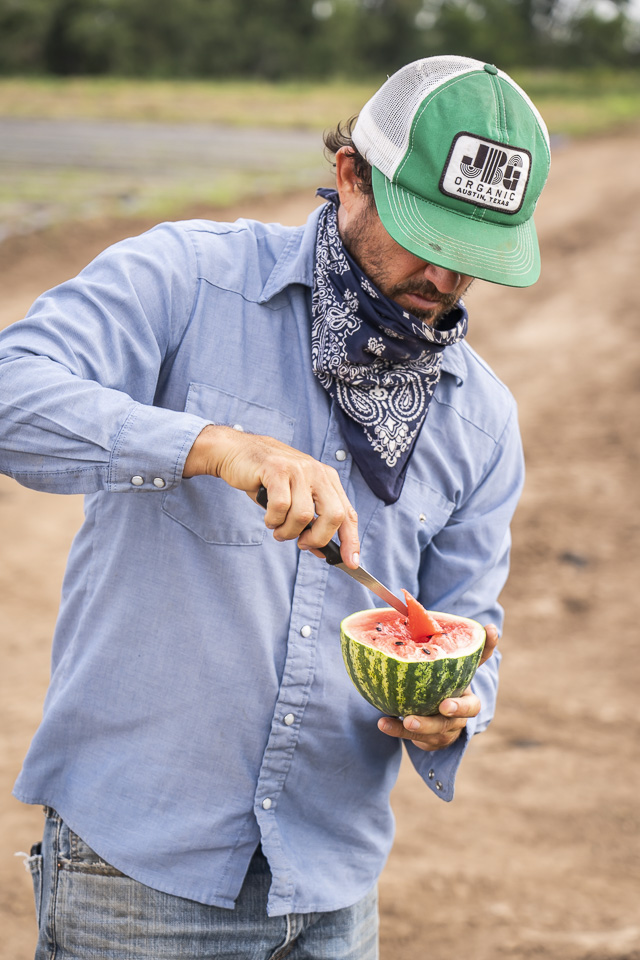 Quality control. Photo by Scott David Gordon.
Quality control. Photo by Scott David Gordon.
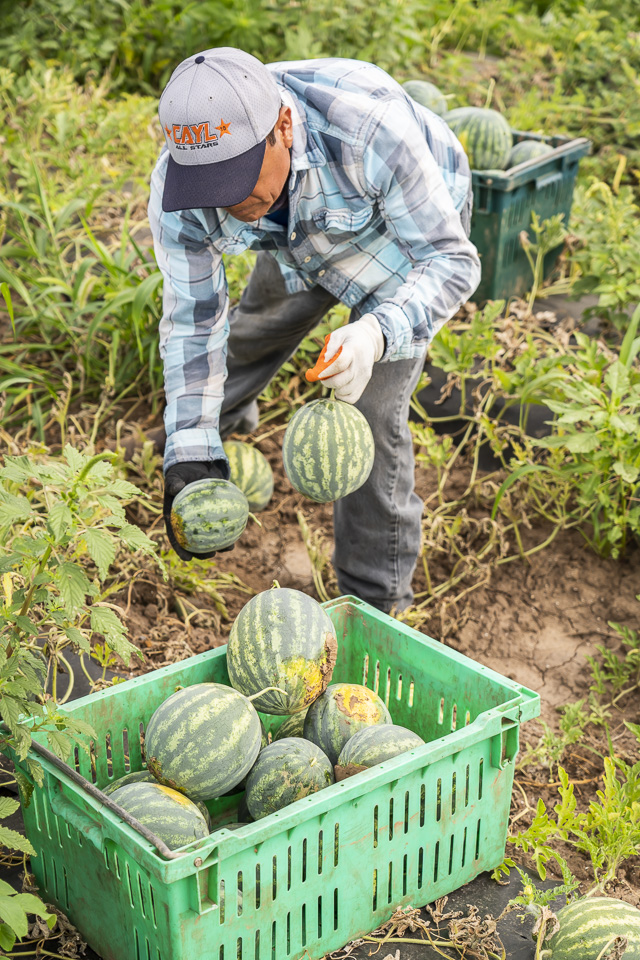 We love these personal sized watermelons - perfect for a CSA share. Photo by Scott David Gordon.
We love these personal sized watermelons - perfect for a CSA share. Photo by Scott David Gordon.
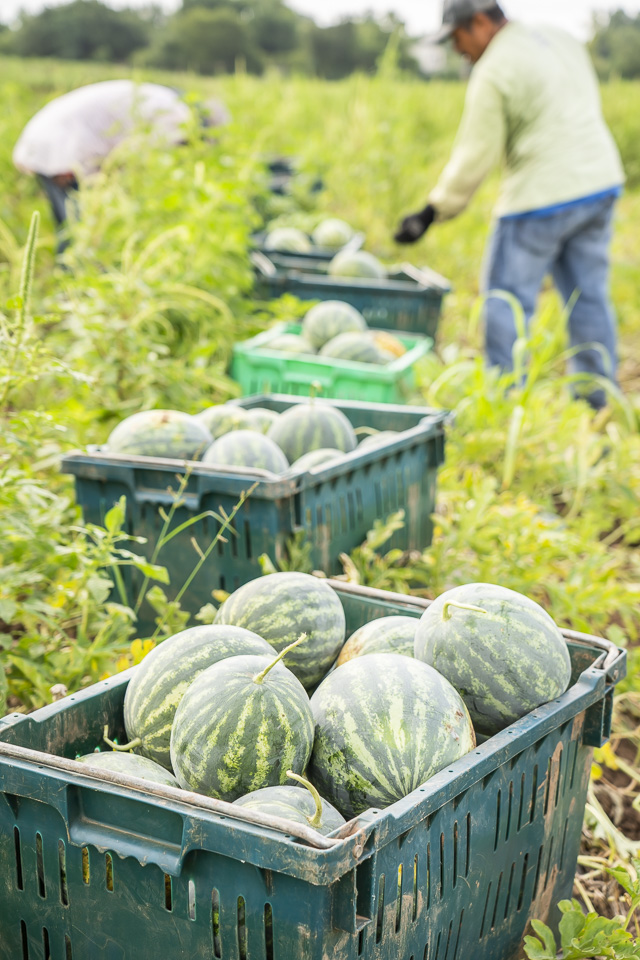 When we're hiring at the farm, most job descriptions read "must be able to lift 50 lbs. repeatedly". Work one melon season, and you'll understand why that line exists. Photo by Scott David Gordon.
When we're hiring at the farm, most job descriptions read "must be able to lift 50 lbs. repeatedly". Work one melon season, and you'll understand why that line exists. Photo by Scott David Gordon.
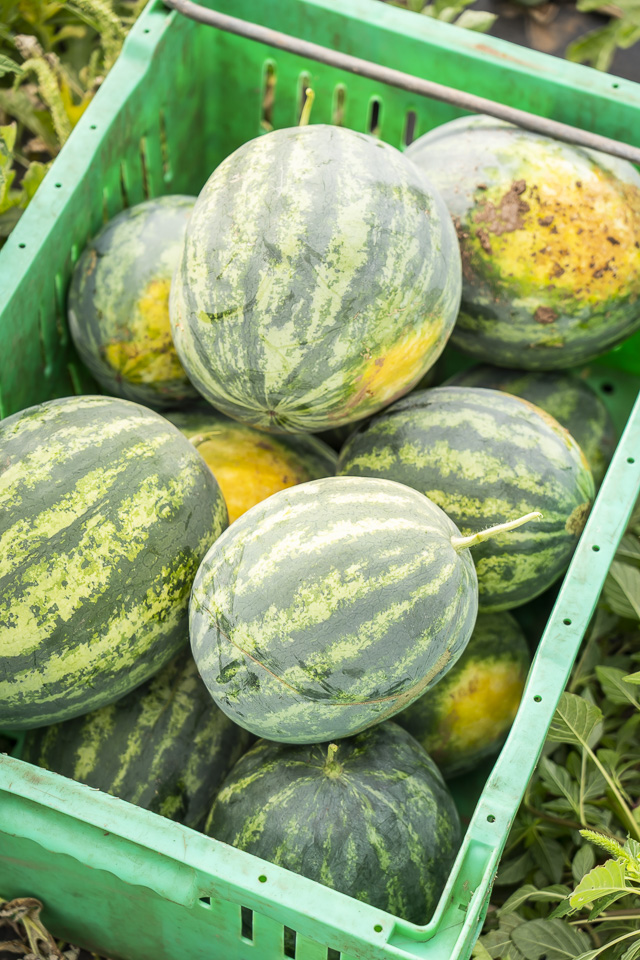 How to pick a good watermelon? The yellow spot often present on one side of a watermelon is called the "field spot", and this is the part of the melon that rests on the ground while it's developing. The darker and more yellow in color the field spot, the more time the melon spent ripening on the vine. A whitish field spot often means that the melon was harvested prematurely! Just look at these lovely yellow field spots. Photo by Scott David Gordon.
How to pick a good watermelon? The yellow spot often present on one side of a watermelon is called the "field spot", and this is the part of the melon that rests on the ground while it's developing. The darker and more yellow in color the field spot, the more time the melon spent ripening on the vine. A whitish field spot often means that the melon was harvested prematurely! Just look at these lovely yellow field spots. Photo by Scott David Gordon.
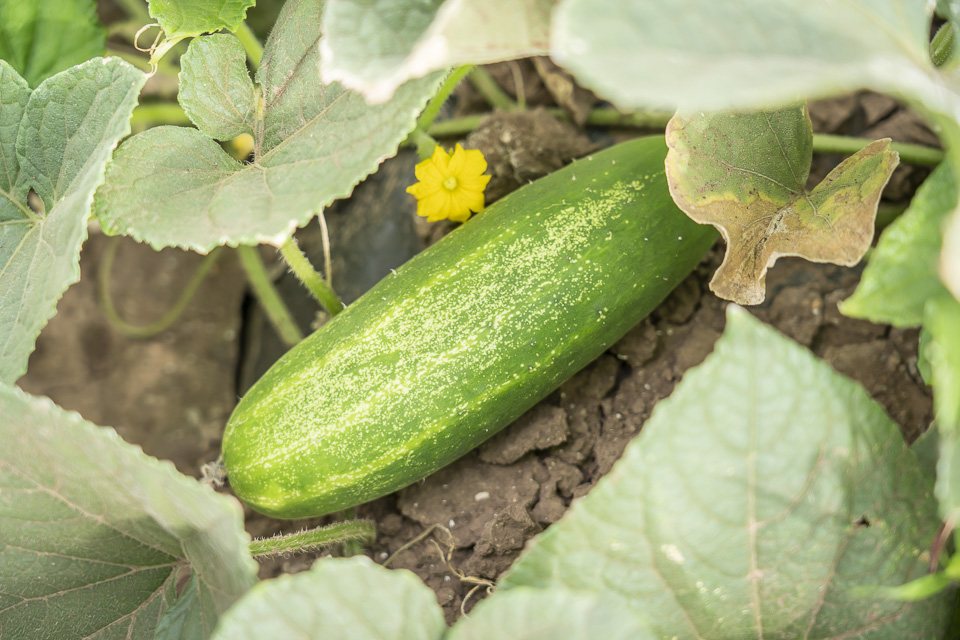 Many home gardeners grow cucumbers up a trellis. At our scale, however, cukes are all grown on the ground and are harvested every single day. Photo by Scott David Gordon.
Many home gardeners grow cucumbers up a trellis. At our scale, however, cukes are all grown on the ground and are harvested every single day. Photo by Scott David Gordon.
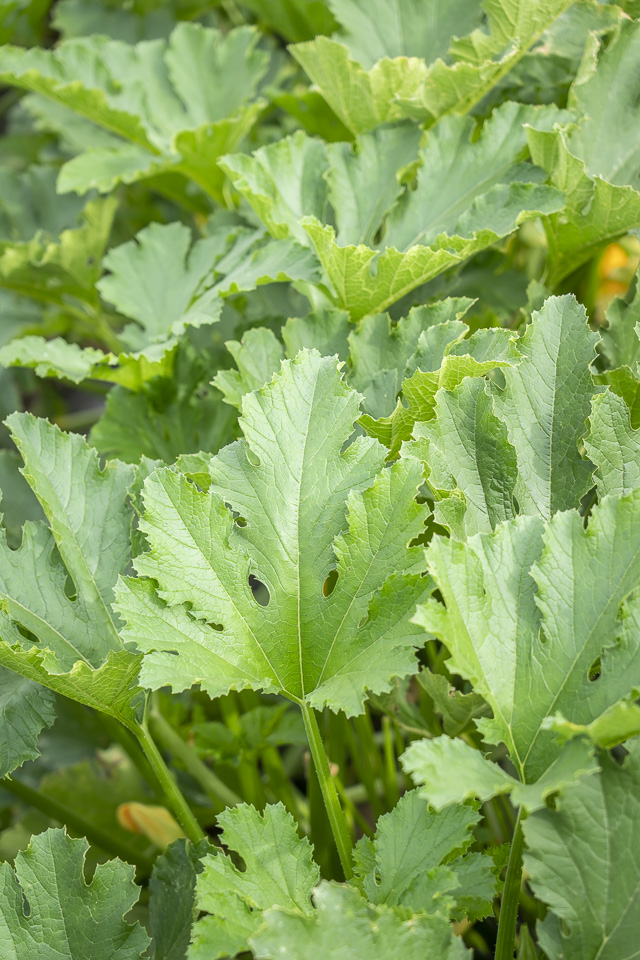 Did you know that squash leaves and stems are edible and are commonly eaten in many global cuisines? We don't harvest squash leaves here at JBG, but we're told that our friends at New Leaf Agriculture do. Photo by Scott David Gordon.
Did you know that squash leaves and stems are edible and are commonly eaten in many global cuisines? We don't harvest squash leaves here at JBG, but we're told that our friends at New Leaf Agriculture do. Photo by Scott David Gordon.
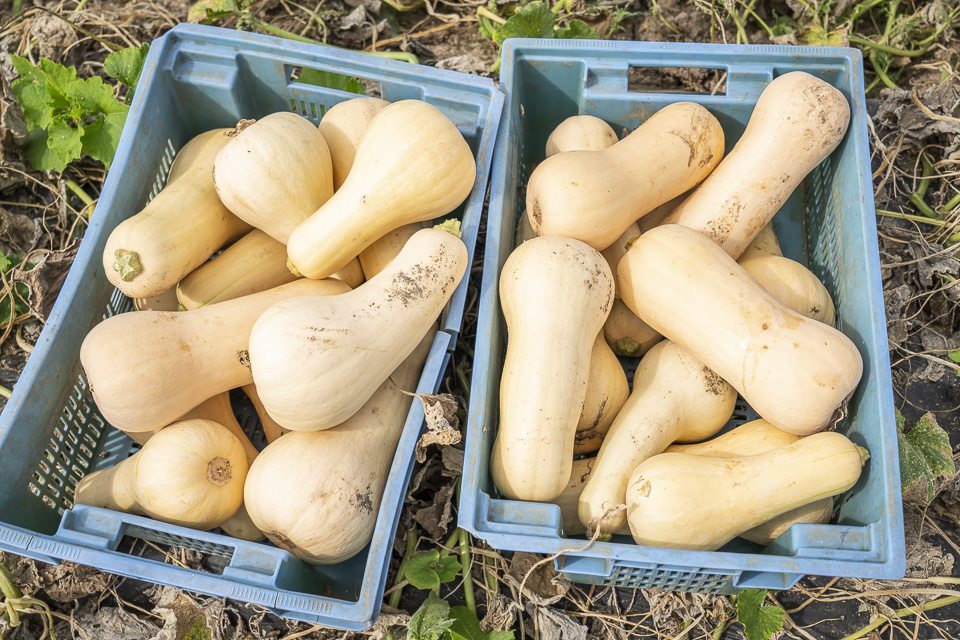 Large harvests of our "winter" squash are rolling in. Butternut, for all! Photo by Scott David Gordon.
Large harvests of our "winter" squash are rolling in. Butternut, for all! Photo by Scott David Gordon.
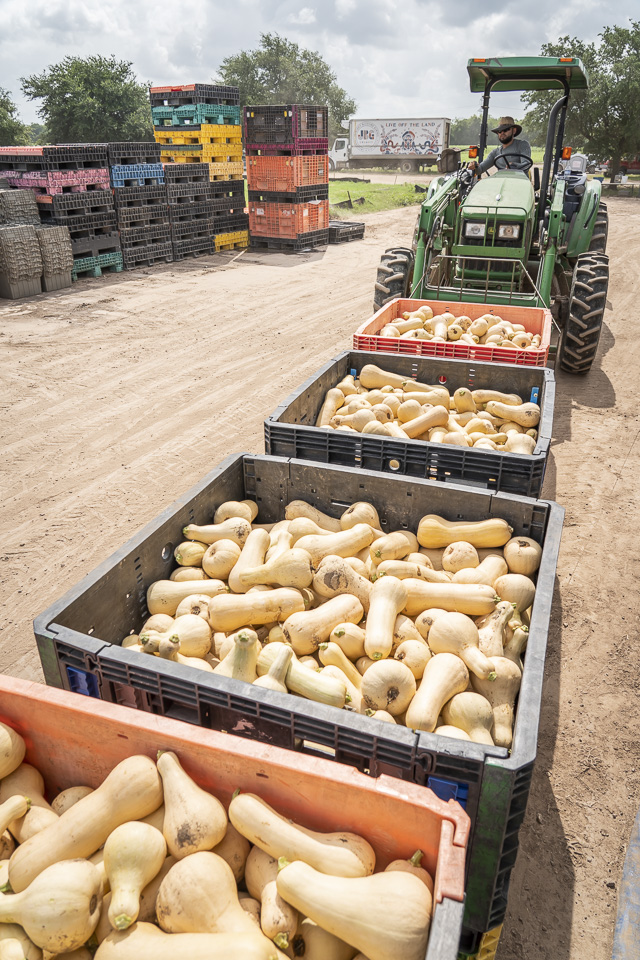 A train of just-harvested butternut squash, ready to be transferred to the coolers. Photo by Scott David Gordon.
A train of just-harvested butternut squash, ready to be transferred to the coolers. Photo by Scott David Gordon.
 The building, washing, and sanitizing IFCOs is one of the less-glamorous parts of working at our Pack Shed. The pile of IFCOs to-be-washed never truly ends. Photo by Scott David Gordon.
The building, washing, and sanitizing IFCOs is one of the less-glamorous parts of working at our Pack Shed. The pile of IFCOs to-be-washed never truly ends. Photo by Scott David Gordon.VEGAN GREENS, MUSHROOM, AND CHEESE FLAUTAS
07/14/20 — Ada Broussard
Recipe and photos created by Robin Beltran, founder of The Black Vegan Company and a JBG Farmers' Market team member who you may have met at one of the weekend markets JBG attends, like the Lone Star or Wolf Ranch market. Thank you Robin for contributing this wonderful flauta recipe!
![]()
What’s the biggest myth about vegan food? That it lacks flavor! I started The Black Vegan Company to combat this misconception about veganism, particularly in multicultural households. In Black and Brown communities, our food is tied to our culture and holds a really special place in our hearts and kitchens. The Black Vegan Company is all about showing people how to adopt a healthier diet without sacrificing flavor and the foods they love.
Our most popular recipe is this vegan greens, mushroom and cheese flauta dish. It’s a favorite because it’s so easy to make and also very low-cost. You can feed an entire family for about 16 bucks! These flautas are crunchy, flakey and so savory. Your family is sure to love them. Try them out and let us know what you think by hitting us up on Instagram, Facebook or Pinterest. And be sure to visit our blog for more flavor-packed vegan recipes.
Servings: Makes 16 flautas (2-3 flautas recommended per serving)
![]()
INGREDIENTS FOR VEGAN FLAUTAS
1. Set a skillet on medium heat, and once hot, add ¼ cup of olive oil, fresh leafy greens and mushrooms. Toss the veggies to coat them with oil.
2. Add paprika, sea salt, crushed red pepper and your choice of unsalted season-all for flavor. Toss the veggies to ensure they are evenly coated. Sautee the mixture until the greens are wilted and soft, which should take about 2-3 minutes. Then, turn off the heat and place the mixture to the side.
3. Take a tortilla and place a strip of cheese towards the edge. On top of the cheese, add roughly a tablespoon of the spinach and mushroom mixture. Be careful not to overly stuff it.
4. Roll the tortilla tightly around the filling and secure it shut with a toothpick. Repeat until all of your mixture is gone.
5. Set a separate frying pan on medium heat, and once hot, add ½ cup of olive oil.
6. Once the oil begins to bubble, use tongs to place the flautas into the pan to begin frying. Turn and cook each side until golden brown, which takes about 2 minutes.
7. Remove the flautas and place them on a paper towel-lined plate to absorb excess oil. Remove toothpicks before serving.
8. Serve flautas with your favorite vegan sour cream or salsa verde and shredded lettuce. Can also be served with black or pinto beans and Mexican rice.
![]()

What’s the biggest myth about vegan food? That it lacks flavor! I started The Black Vegan Company to combat this misconception about veganism, particularly in multicultural households. In Black and Brown communities, our food is tied to our culture and holds a really special place in our hearts and kitchens. The Black Vegan Company is all about showing people how to adopt a healthier diet without sacrificing flavor and the foods they love.
Our most popular recipe is this vegan greens, mushroom and cheese flauta dish. It’s a favorite because it’s so easy to make and also very low-cost. You can feed an entire family for about 16 bucks! These flautas are crunchy, flakey and so savory. Your family is sure to love them. Try them out and let us know what you think by hitting us up on Instagram, Facebook or Pinterest. And be sure to visit our blog for more flavor-packed vegan recipes.
Servings: Makes 16 flautas (2-3 flautas recommended per serving)

INGREDIENTS FOR VEGAN FLAUTAS
- 16 flour tortillas (Recommended: Central Market Vegan Flour Tortillas)
- 5-6 vegan cheese slices cut into strips (Recommended: Chao Field Roast)
- 2 cups of roughly chopped seasonal greens: amaranth or sweet potato greens (summer), or spinach or chard greens (winter)
- 2 cups of finely chopped mushrooms
- ¾ cup of olive oil (¼ for sautéing and ½ for frying)
- ¼ cup of paprika
- 1 tbsp of sea salt
- 1 tsp of crushed red pepper
- ½ cup unsalted season-all (Recommended: Central Market Adobo Seasoning)
- wooden toothpicks
1. Set a skillet on medium heat, and once hot, add ¼ cup of olive oil, fresh leafy greens and mushrooms. Toss the veggies to coat them with oil.
2. Add paprika, sea salt, crushed red pepper and your choice of unsalted season-all for flavor. Toss the veggies to ensure they are evenly coated. Sautee the mixture until the greens are wilted and soft, which should take about 2-3 minutes. Then, turn off the heat and place the mixture to the side.
3. Take a tortilla and place a strip of cheese towards the edge. On top of the cheese, add roughly a tablespoon of the spinach and mushroom mixture. Be careful not to overly stuff it.
4. Roll the tortilla tightly around the filling and secure it shut with a toothpick. Repeat until all of your mixture is gone.
5. Set a separate frying pan on medium heat, and once hot, add ½ cup of olive oil.
6. Once the oil begins to bubble, use tongs to place the flautas into the pan to begin frying. Turn and cook each side until golden brown, which takes about 2 minutes.
7. Remove the flautas and place them on a paper towel-lined plate to absorb excess oil. Remove toothpicks before serving.
8. Serve flautas with your favorite vegan sour cream or salsa verde and shredded lettuce. Can also be served with black or pinto beans and Mexican rice.
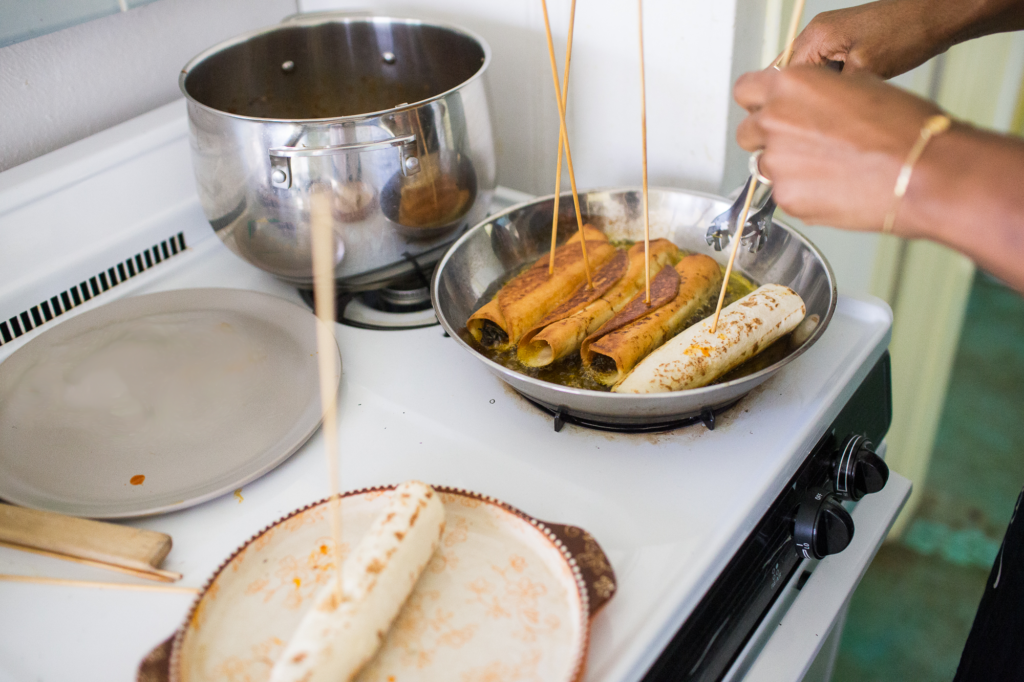
CSA BOX CONTENTS WEEK OF JULY 13TH
07/14/20 — Scott
 CSA Box Contents Week of July 13th
CSA Box Contents Week of July 13th
Large Box
Beets
Cucumber
Eggplant
Greens, Dandelion
Herb, Farmers Choice
Leek
Melon, Farmers Choice
Pepper, Hot Medley
Pepper, Sweet Medley
Potato
Squash. Summer Medley
Winter Squash
Beets
Cucumber
Eggplant
Greens, Dandelion
Herb, Farmers Choice
Leek
Melon, Farmers Choice
Pepper, Hot Medley
Pepper, Sweet Medley
Potato
Squash. Summer Medley
Winter Squash
Medium Box
Beets
Cucumber
Eggplant
Herb, Farmers Choice
Herb, Lemongrass
Melon, Farmers Choice
Okra
Pepper, Sweet Medley
Potato
Winter Squash
Beets
Cucumber
Eggplant
Herb, Farmers Choice
Herb, Lemongrass
Melon, Farmers Choice
Okra
Pepper, Sweet Medley
Potato
Winter Squash
Small Box
Beets
Cucumber
Herb, Farmers Choice
Melon, Farmers Choice
Okra
Pepper, Sweet Medley
Potato
Beets
Cucumber
Herb, Farmers Choice
Melon, Farmers Choice
Okra
Pepper, Sweet Medley
Potato
Individual Box
Cucumber
Herb, Farmers Choice
Melon, Farmers Choice
Pepper, Sweet Medley
Potato
Winter Squash
Cucumber
Herb, Farmers Choice
Melon, Farmers Choice
Pepper, Sweet Medley
Potato
Winter Squash
CSA BOX CONTENTS WEEK OF JULY 13TH
07/14/20 — Scott
 CSA Box Contents Week of July 13th
CSA Box Contents Week of July 13th
Large Box
Beets
Cucumber
Herb, Farmers Choice
Melon, Farmers Choice
Pepper, Hot Medley
Pepper, Shishito
Pepper, Sweet
Potato
Squash, Farmer's Choice
Tomato
Winter Squash
OKRA RECIPES FROM AROUND THE WORLD
07/17/20 — Ada Broussard
Okra plants are related to hibiscus and cotton plants with tropical looking flowers that scream of an equatorial evolution. The earliest known evidence of okra cultivation comes from Ethiopia. Egyptian cultivation of the crop was common by the 12th century B.C., and okra became a prevalent crop in North Africa and the Middle East where the plant could stand up to the hot temperatures. Okra seeds traveled to India along trade routes and to the Caribbeans and Americas via the slave trade, and today, the young seed pods are harvested and chopped up all around the world. There are even Greek and Turkish dishes that celebrate the pods (both regions that used to be under Ottoman control). Caffeine-free coffee alternatives are made with the roasted seeds, and scientists are studying okra slime as a means to make biodegradable food packaging.
![]() Okra in hand. Photo by Scott David Gordon.
Okra in hand. Photo by Scott David Gordon.
Okra’s “mucilage”, or the slime factor, is an inherent quality of the vegetables. Roasting the pods whole in a very hot oven can minimize the slime, but really, okra is slime. In fact, this slimy quality is often wielded as an advantage, used to thicken soups and stews. Okra is as polarizing as cilantro and is a take-it or leave-it vegetable for many. If you’re on team “take-it” but are growing weary of your usual okra dishes, we’ve got a few recipes from around the world to spice up your okra experience. Disclaimer: what you won’t see below is a fried okra recipe because we’re working off the assumption that you’re already doing this. If not, better hurry. This peculiar and unique pod won’t be around forever!
![]() Swimming (JBG) okra. Photo by JBG recipe developer and food photographer, Mackenzie Smith.
Swimming (JBG) okra. Photo by JBG recipe developer and food photographer, Mackenzie Smith.
Gumbo: The word gumbo is actually a derivative of a West African word for okra, and in many Créole gumbo recipes, okra is a main ingredient used to thicken the stew. If you ask us, it’s a big hot for gumbo at the moment. Do your future self a favor, and chop, blanch, and freeze your next clamshell of JBG okra. It will be waiting for you just in time for the first cold snap of the fall, sitting next to your popsicles and cheering you along through the hot, hot summer.
![]() Okra leaves and flowers, reaching for the sky. Photo by Scott David Gordon.
Okra leaves and flowers, reaching for the sky. Photo by Scott David Gordon.
Bindi Masala: This is an Indian dish of cooked okra (or "ladyfingers") with toasted spices, and sometimes other vegetables like onions and tomatoes. If you like Indian cuisine and haven’t dabbled into the world of Youtube tutorials on popular Indian dishes, buckle up. There are so many wonderful home cooks sharing their recipes on Youtube. Here is just one of many videos we found for bindi masala. We checked in with our operations manger, Krishna, to see if he had any tips for making bindi masala at home. He said that you can eat bindi masala as a side dish, or can even roll the okra stir fry in a tortilla (which should probably be heated and brushed with ghee ) .
![]() Green okra, ready to roll. Photo by Scott David Gordon.
Green okra, ready to roll. Photo by Scott David Gordon.
Bamya: Tomatoes and okra both come into season during the same hot moments every summer and so it should be no surprise that many okra recipes from around the world pair acidic tomatoes with silky (slimy?) okra. The two just go together. Bamya, the word for okra in Arabic, is also the name of an Egyptian okra and tomato stew , often containing lamb or beef, and sometimes served with spaghetti noodles! Unlike the 2-5 (sometimes 6!) inch okra that you’ll often find in the United States, okra in other parts of the world are harvested when they’re so tiny - shy of even an inch! Baby Bamya!
![]() Bulk okra at market.Must be summer! Photo by Scott David Gordon.
Bulk okra at market.Must be summer! Photo by Scott David Gordon.
Maafe: Maafe is the word for a West African peanut (or groundnut!) stew, of which there are many, many variations, some involving proteins like beef or chicken, and some involving vegetables like tomatoes, corn, and the pod of the hour: okra. Whereas so many okra recipes lean on the acid side (thank you, tomatoes), this stew envelopes okra in a creamy and rich sauce that will surely be an okra expedition for many. This recipe from the blog Chocolate for Basil seems like a great starting point to these West African flavors.
![]() Okra pods have tiny hairs that can irritate the skin after a prolonged period of harvesting. Thankfully, there is an easy solution: gloves. Photo by Scott David Gordon.
Okra pods have tiny hairs that can irritate the skin after a prolonged period of harvesting. Thankfully, there is an easy solution: gloves. Photo by Scott David Gordon.
Okra Ohitashi: Cold, marinated okra might be your next favorite way to enjoy this vegetable. Ohitashi refers to a Japanese dish that is, most simply, a blanched vegetable soaked in dashi, or a Japanese umami-rich broth made a number of ways, depending on the type. Making a simple dashi at home is easy, and blanching okra is literally as easy as boiling water. We love this recipe for okra ohitashi and the gateway it provides to ohitashi of all types. CSA Members, take note! Here is a gateway cooking technique with endless seasonal variations!
![]() If consistently picked, okra plants will continue to grow tall, all season long, with the fresh pods emerging at the top of the strong stalk. Photo by Scott David Gordon.
If consistently picked, okra plants will continue to grow tall, all season long, with the fresh pods emerging at the top of the strong stalk. Photo by Scott David Gordon.
Coconut Okra Rice: We thought we were done suggesting okra recipes until we stumbled upon this recipe from The Caribbean Pot which makes a rice pilaf, of sorts, with okra and coconut milk. This recipe calls for a medley of peppers, both hot and sweet, making it a perfect one-pot summer dish to show off some seasonal veg.
Go forth, and okra!
 Okra in hand. Photo by Scott David Gordon.
Okra in hand. Photo by Scott David Gordon.
Okra’s “mucilage”, or the slime factor, is an inherent quality of the vegetables. Roasting the pods whole in a very hot oven can minimize the slime, but really, okra is slime. In fact, this slimy quality is often wielded as an advantage, used to thicken soups and stews. Okra is as polarizing as cilantro and is a take-it or leave-it vegetable for many. If you’re on team “take-it” but are growing weary of your usual okra dishes, we’ve got a few recipes from around the world to spice up your okra experience. Disclaimer: what you won’t see below is a fried okra recipe because we’re working off the assumption that you’re already doing this. If not, better hurry. This peculiar and unique pod won’t be around forever!
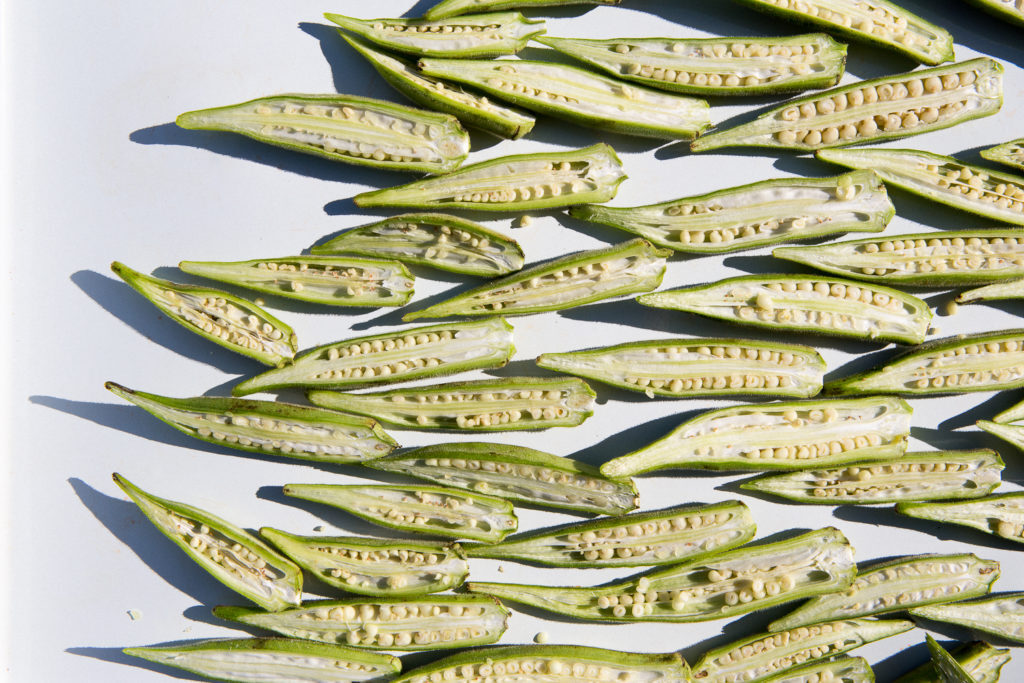 Swimming (JBG) okra. Photo by JBG recipe developer and food photographer, Mackenzie Smith.
Swimming (JBG) okra. Photo by JBG recipe developer and food photographer, Mackenzie Smith.
Gumbo: The word gumbo is actually a derivative of a West African word for okra, and in many Créole gumbo recipes, okra is a main ingredient used to thicken the stew. If you ask us, it’s a big hot for gumbo at the moment. Do your future self a favor, and chop, blanch, and freeze your next clamshell of JBG okra. It will be waiting for you just in time for the first cold snap of the fall, sitting next to your popsicles and cheering you along through the hot, hot summer.
 Okra leaves and flowers, reaching for the sky. Photo by Scott David Gordon.
Okra leaves and flowers, reaching for the sky. Photo by Scott David Gordon.
Bindi Masala: This is an Indian dish of cooked okra (or "ladyfingers") with toasted spices, and sometimes other vegetables like onions and tomatoes. If you like Indian cuisine and haven’t dabbled into the world of Youtube tutorials on popular Indian dishes, buckle up. There are so many wonderful home cooks sharing their recipes on Youtube. Here is just one of many videos we found for bindi masala. We checked in with our operations manger, Krishna, to see if he had any tips for making bindi masala at home. He said that you can eat bindi masala as a side dish, or can even roll the okra stir fry in a tortilla (which should probably be heated and brushed with ghee ) .
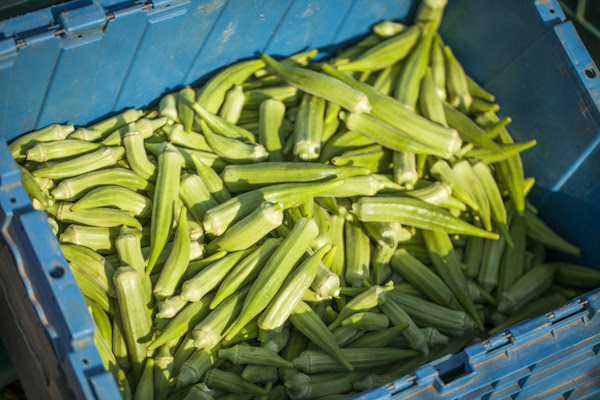 Green okra, ready to roll. Photo by Scott David Gordon.
Green okra, ready to roll. Photo by Scott David Gordon.
Bamya: Tomatoes and okra both come into season during the same hot moments every summer and so it should be no surprise that many okra recipes from around the world pair acidic tomatoes with silky (slimy?) okra. The two just go together. Bamya, the word for okra in Arabic, is also the name of an Egyptian okra and tomato stew , often containing lamb or beef, and sometimes served with spaghetti noodles! Unlike the 2-5 (sometimes 6!) inch okra that you’ll often find in the United States, okra in other parts of the world are harvested when they’re so tiny - shy of even an inch! Baby Bamya!
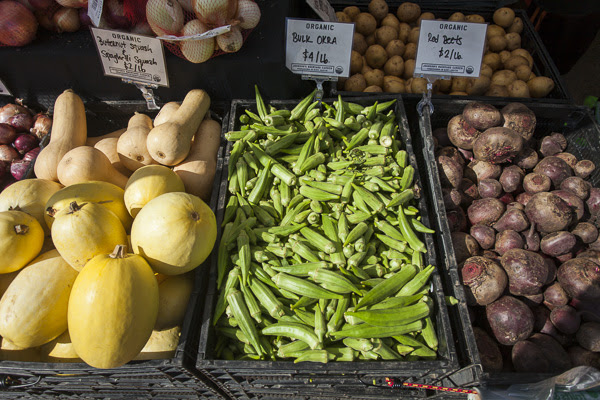 Bulk okra at market.Must be summer! Photo by Scott David Gordon.
Bulk okra at market.Must be summer! Photo by Scott David Gordon.
Maafe: Maafe is the word for a West African peanut (or groundnut!) stew, of which there are many, many variations, some involving proteins like beef or chicken, and some involving vegetables like tomatoes, corn, and the pod of the hour: okra. Whereas so many okra recipes lean on the acid side (thank you, tomatoes), this stew envelopes okra in a creamy and rich sauce that will surely be an okra expedition for many. This recipe from the blog Chocolate for Basil seems like a great starting point to these West African flavors.
 Okra pods have tiny hairs that can irritate the skin after a prolonged period of harvesting. Thankfully, there is an easy solution: gloves. Photo by Scott David Gordon.
Okra pods have tiny hairs that can irritate the skin after a prolonged period of harvesting. Thankfully, there is an easy solution: gloves. Photo by Scott David Gordon.
Okra Ohitashi: Cold, marinated okra might be your next favorite way to enjoy this vegetable. Ohitashi refers to a Japanese dish that is, most simply, a blanched vegetable soaked in dashi, or a Japanese umami-rich broth made a number of ways, depending on the type. Making a simple dashi at home is easy, and blanching okra is literally as easy as boiling water. We love this recipe for okra ohitashi and the gateway it provides to ohitashi of all types. CSA Members, take note! Here is a gateway cooking technique with endless seasonal variations!
 If consistently picked, okra plants will continue to grow tall, all season long, with the fresh pods emerging at the top of the strong stalk. Photo by Scott David Gordon.
If consistently picked, okra plants will continue to grow tall, all season long, with the fresh pods emerging at the top of the strong stalk. Photo by Scott David Gordon.
Coconut Okra Rice: We thought we were done suggesting okra recipes until we stumbled upon this recipe from The Caribbean Pot which makes a rice pilaf, of sorts, with okra and coconut milk. This recipe calls for a medley of peppers, both hot and sweet, making it a perfect one-pot summer dish to show off some seasonal veg.
Go forth, and okra!
CSA BOX CONTENTS WEEK OF JULY 20TH
07/20/20 — Scott
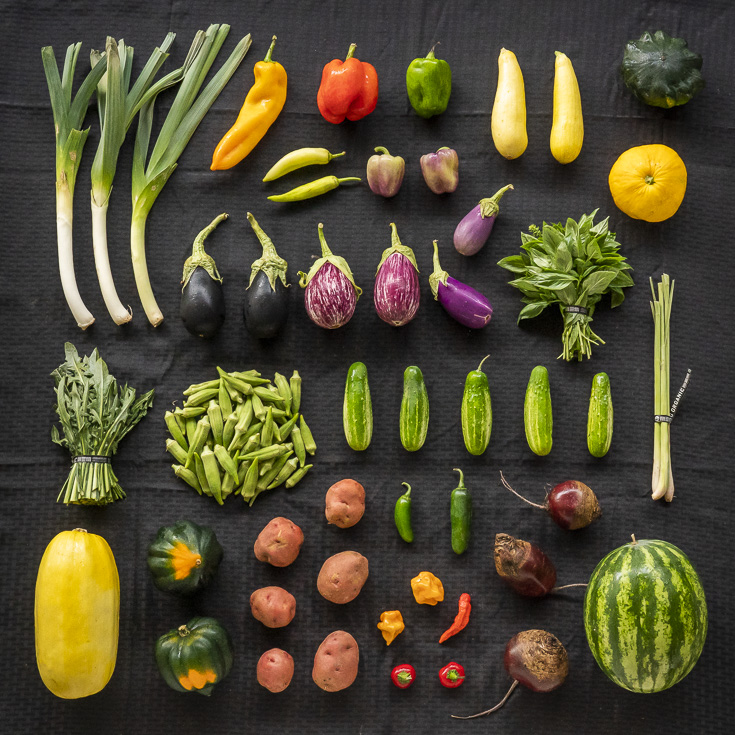 CSA Box Contents Week of July 20th
CSA Box Contents Week of July 20th
Large Box
Beets
Eggplant
Farmers Choice
Greens, Dandelion
Greens, Sweet Potato
Herb, Basil
Melon, Farmers Choice
Okra
Pepper, Sweet
Potato
Radish
Winter Squash
Beets
Eggplant
Farmers Choice
Greens, Dandelion
Greens, Sweet Potato
Herb, Basil
Melon, Farmers Choice
Okra
Pepper, Sweet
Potato
Radish
Winter Squash
Medium Box
Beets
Farmers Choice
Herb, Basil
Leek
Melon, Farmers Choice
Okra
Pepper, Sweet
Potato
Squash, Farmer's Choice
Winter Squash
Beets
Farmers Choice
Herb, Basil
Leek
Melon, Farmers Choice
Okra
Pepper, Sweet
Potato
Squash, Farmer's Choice
Winter Squash
Small Box
Eggplant
Greens, Sweet Potato
Herb, Basil
Leek
Pepper, Sweet
Potato
Squash, Patty Pan
Eggplant
Greens, Sweet Potato
Herb, Basil
Leek
Pepper, Sweet
Potato
Squash, Patty Pan
Individual Box
Beets
Eggplant
Okra
Pepper, Sweet
Winter Squash
Beets
Eggplant
Okra
Pepper, Sweet
Winter Squash
CSA BOX CONTENTS WEEK OF JULY 20TH
07/21/20 — Scott
 CSA Box Contents Week of July 20th
CSA Box Contents Week of July 20th
Large Box
Beets
Cucumber
Eggplant
Farmers Choice
Herb, Farmers Choice
Leek
Melon, Farmers Choice
Pepper, Hot Medley
Pepper, Sweet Medley
Potato
Squash. Summer Medley
Winter Squash
LIMA BEANS WITH TANGY TOMATOES, OLIVE OIL & FETA CHEESE
07/23/20 — Ada Broussard
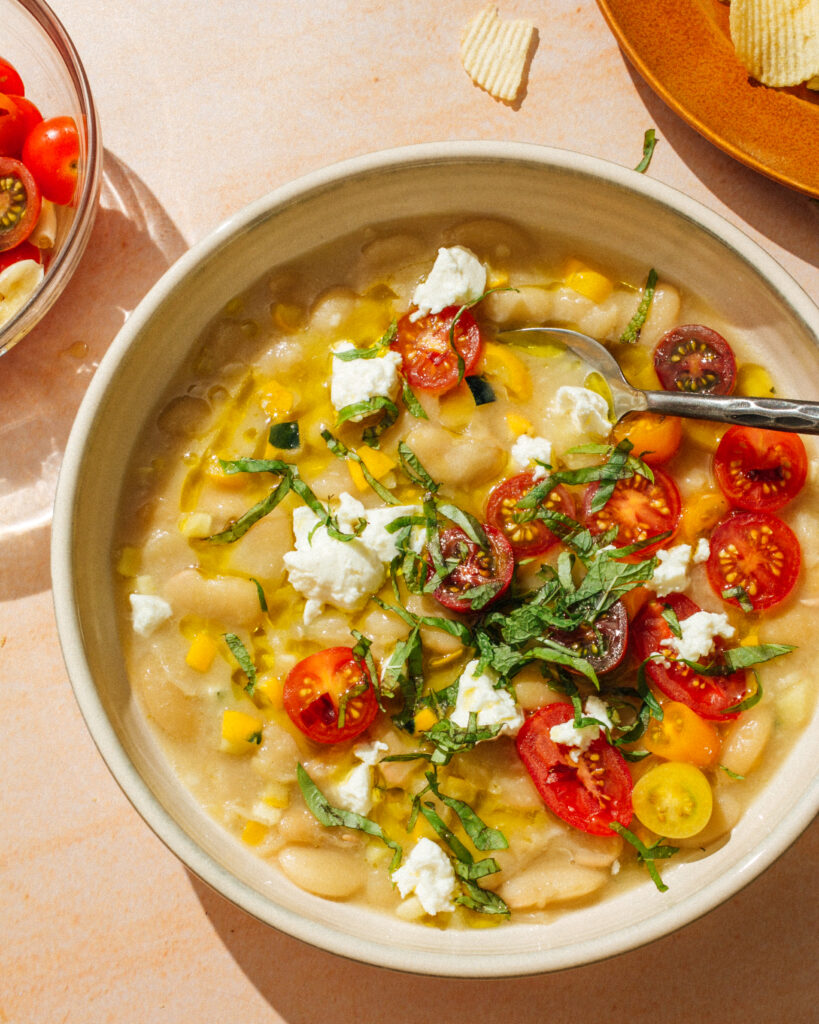 Recipe and photos by Mackenzie Smith.
Recipe and photos by Mackenzie Smith.
This week I made lima beans, and stirred in diced Summer squash just as the beans finished cooking, then topped each bowl with tangy tomatoes that had been hanging out in a bath of red wine vinegar, smashed garlic and dried chiles. Finished with a drizzle of olive oil, fresh herbs, feta cheese and a handful of crushed potato chips— these beans were a hit for the whole family.
- 1 pound dried lima beans
- 7 cups water or chicken stock or vegetable stock (aka any kind of flavorful liquid - adjust
- seasoning to taste if using water)
- 3 cloves garlic, smashed and peeled
- 1 sprig rosemary
- 2 teaspoons kosher salt (or 1 teaspoon table salt)
- 2 tablespoons butter
- 2 medium-sized yellow squash or zucchini, or a small pattypan — diced
- 4-5 tablespoons red wine vinegar
- 4 cloves garlic, smashed
- 1-2 teaspoons salt
- chili flakes to taste
- 1 cup cherry tomatoes, sliced in half — or a large tomato, diced
- fresh mint and basil
- extra virgin olive oil
- potato chips
Once ingredients listed above are in the inner pot, cover it: twist to lock the lid, and turn the valve to sealing. Use Manual mode and set to 25 minutes.
While beans are cooking, put a few cloves of smashed garlic and a teaspoon of salt into 4-5 tablespoons of red wine vinegar and chile flakes. Dice squash into small cubes. Slice or chop tomatoes and add to vinegar. (Remove garlic before serving).
When the timer on the Instant Pot beeps, allow the pressure to release naturally for 20 minutes. Then, turn the valve to venting.
If beans are not soft enough, put the lid back on and make sure the release valve is set to sealing. Use Manual mode to cook at high pressure for another 5. The pot will quickly come back up to pressure because the contents are already hot.
When beans are soft enough, remove from heat and stir in chopped squash. Salt to taste.
Ladle beans and squash into bowls, drizzle with olive oil, sprinkle with feta, and scoop some of the tangy tomatoes onto the beans, along with fresh chopped mint and basil. Topping with crushed potato chips optional but highly recommended :)
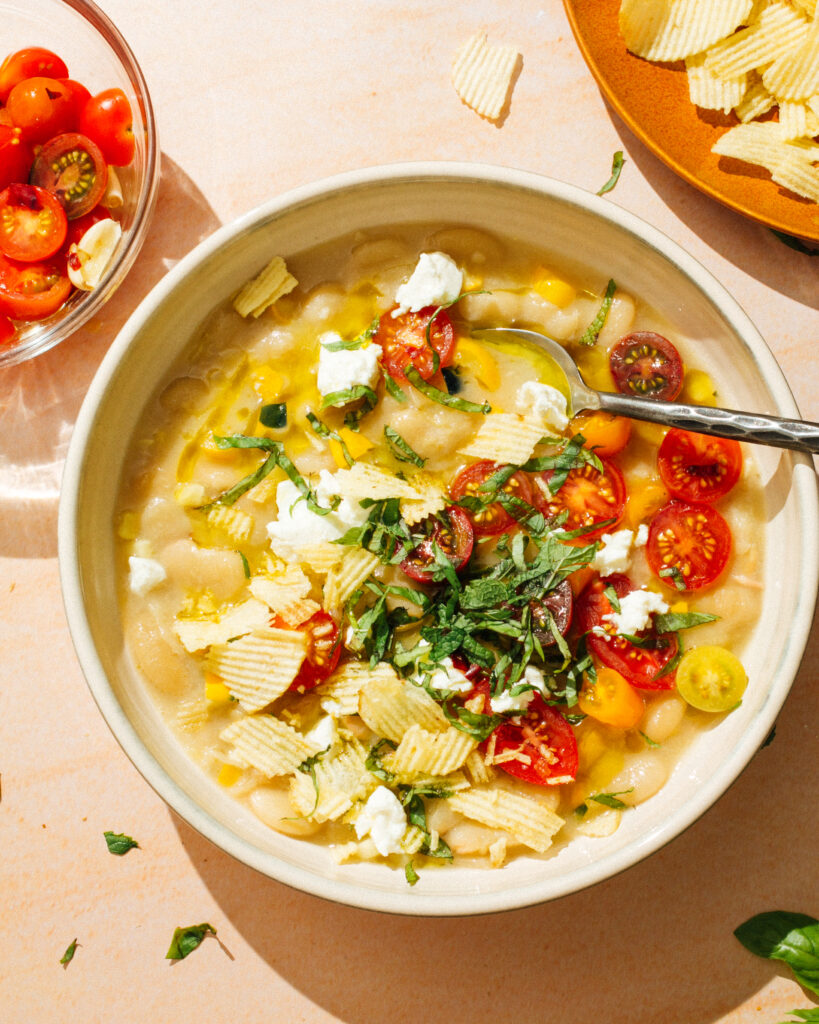 Topping with potato chips is optional, but highly recommended. Photo by Mackenzie Smith.
Topping with potato chips is optional, but highly recommended. Photo by Mackenzie Smith.PHOTOS FROM THE FARM: 7.24.20
07/24/20 — Ada Broussard
This week at the farm Scott captured images of the okra, harvesting eggplant, basil and other herbs in the herb patch, lemongrass, some new plantings just coming up, and some very colorful peppers. Amazing how the farm just keeps going year round!
![]() Morning skies over fields of okra. Photo by Scott David Gordon
Morning skies over fields of okra. Photo by Scott David Gordon
![]() Okra detail from above. Photo by Scott David Gordon
Okra detail from above. Photo by Scott David Gordon
![]() What an eggplant bounty! Photo by Scott David Gordon
What an eggplant bounty! Photo by Scott David Gordon
![]() The rig that allows the harvest of five rows of plants at one pass. Photo by Scott David Gordon
The rig that allows the harvest of five rows of plants at one pass. Photo by Scott David Gordon
![]() Mounds of Black Beauty Eggplant. Photo by Scott David Gordon
Mounds of Black Beauty Eggplant. Photo by Scott David Gordon
![]() Consolidating the bins. Photo by Scott David Gordon
Consolidating the bins. Photo by Scott David Gordon
![]() Harvesting Basil. Photo by Scott David Gordon
Harvesting Basil. Photo by Scott David Gordon
![]() Basil bunch. Photo by Scott David Gordon
Basil bunch. Photo by Scott David Gordon
![]() The gorgeous hues of Thai basil. Photo by Scott David Gordon
The gorgeous hues of Thai basil. Photo by Scott David Gordon
![]() Bringing in the herbs. Photo by Scott David Gordon
Bringing in the herbs. Photo by Scott David Gordon
![]() Lemongrass harvest. Photo by Scott David Gordon
Lemongrass harvest. Photo by Scott David Gordon
![]() Lemongrass. Photo by Scott David Gordon
Lemongrass. Photo by Scott David Gordon
![]() New plantings, even as it gets hot! Photo by Scott David Gordon
New plantings, even as it gets hot! Photo by Scott David Gordon
![]() Purple bell peppers. Photo by Scott David Gordon
Purple bell peppers. Photo by Scott David Gordon
![]() Bin of purple bells. Photo by Scott David Gordon
Bin of purple bells. Photo by Scott David Gordon
![]() Hot cherry bomb peppers, with heat comparable to jalapenos. Photo by Scott David Gordon
Hot cherry bomb peppers, with heat comparable to jalapenos. Photo by Scott David Gordon
 Morning skies over fields of okra. Photo by Scott David Gordon
Morning skies over fields of okra. Photo by Scott David Gordon
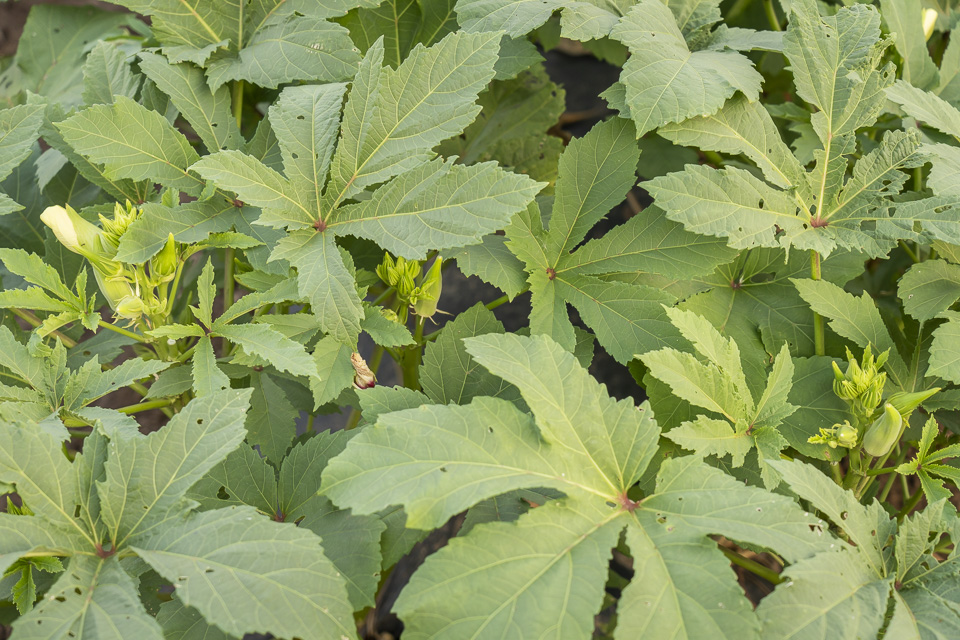 Okra detail from above. Photo by Scott David Gordon
Okra detail from above. Photo by Scott David Gordon
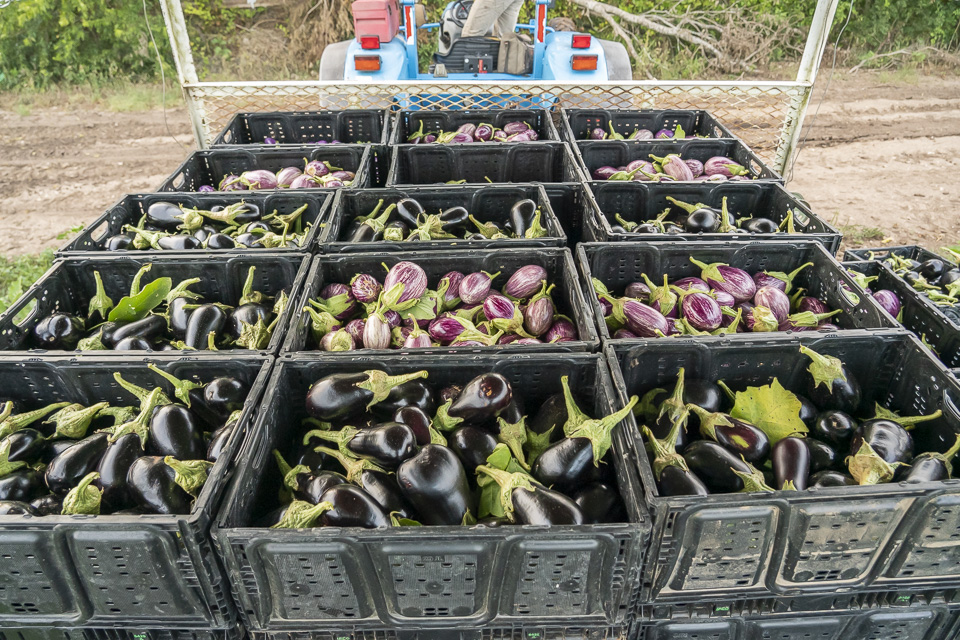 What an eggplant bounty! Photo by Scott David Gordon
What an eggplant bounty! Photo by Scott David Gordon
 The rig that allows the harvest of five rows of plants at one pass. Photo by Scott David Gordon
The rig that allows the harvest of five rows of plants at one pass. Photo by Scott David Gordon
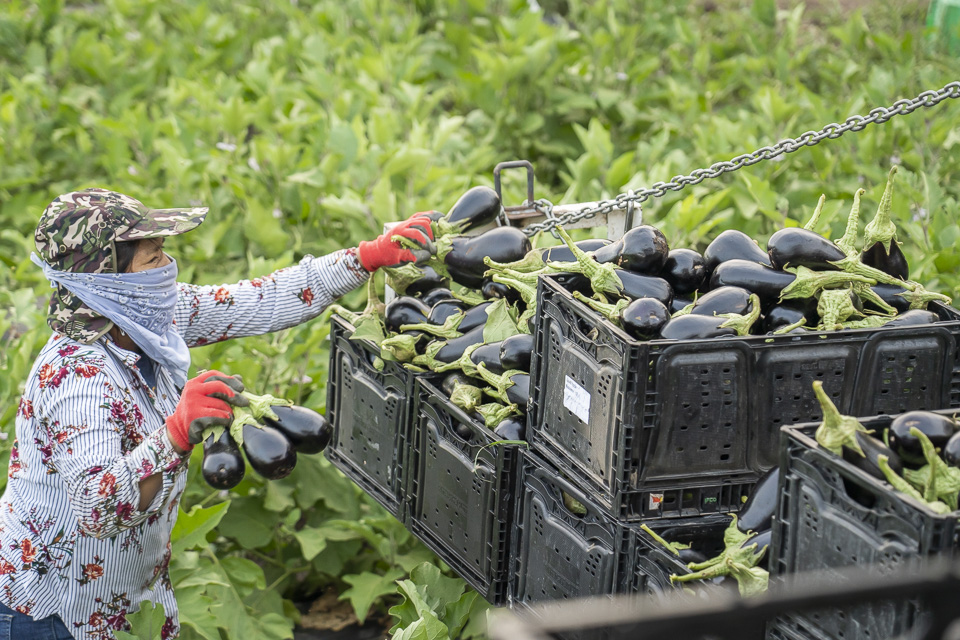 Mounds of Black Beauty Eggplant. Photo by Scott David Gordon
Mounds of Black Beauty Eggplant. Photo by Scott David Gordon
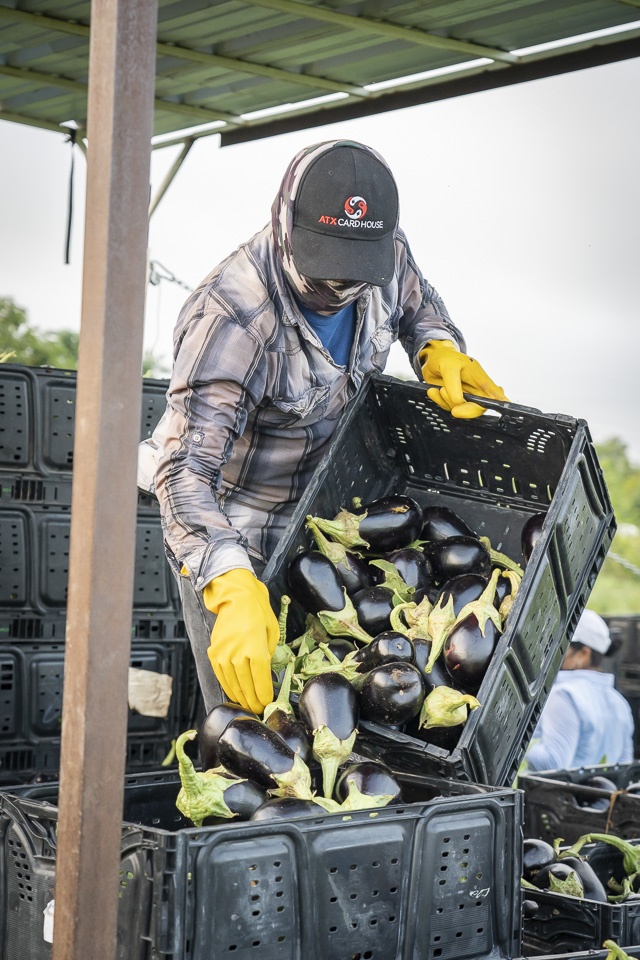 Consolidating the bins. Photo by Scott David Gordon
Consolidating the bins. Photo by Scott David Gordon
 Harvesting Basil. Photo by Scott David Gordon
Harvesting Basil. Photo by Scott David Gordon
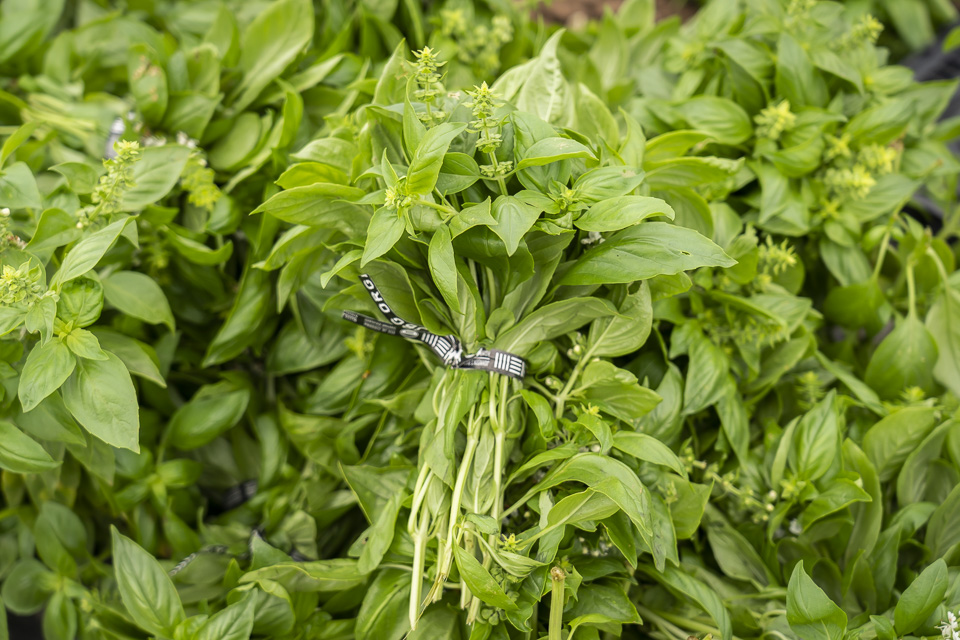 Basil bunch. Photo by Scott David Gordon
Basil bunch. Photo by Scott David Gordon
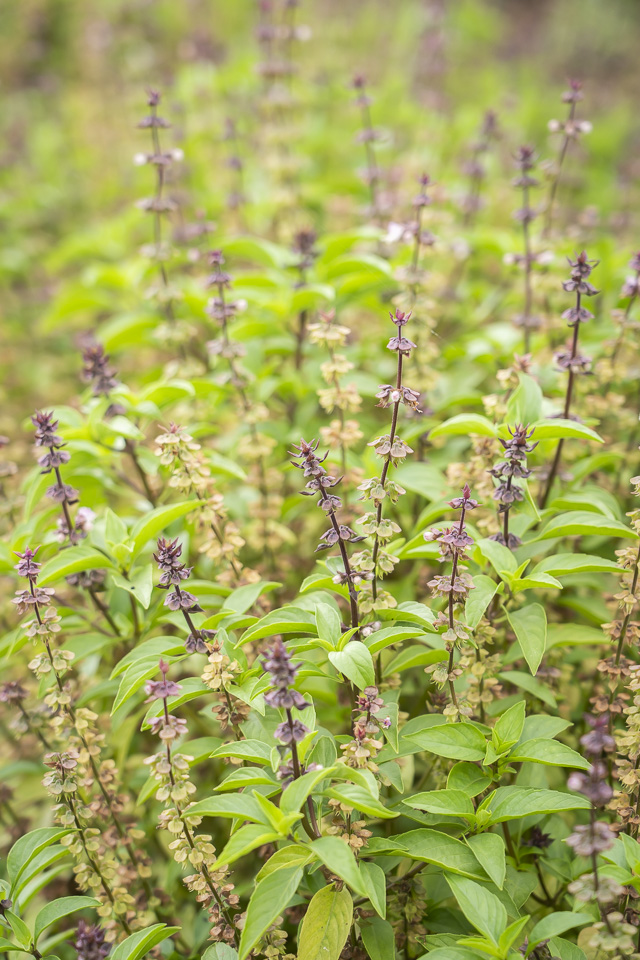 The gorgeous hues of Thai basil. Photo by Scott David Gordon
The gorgeous hues of Thai basil. Photo by Scott David Gordon
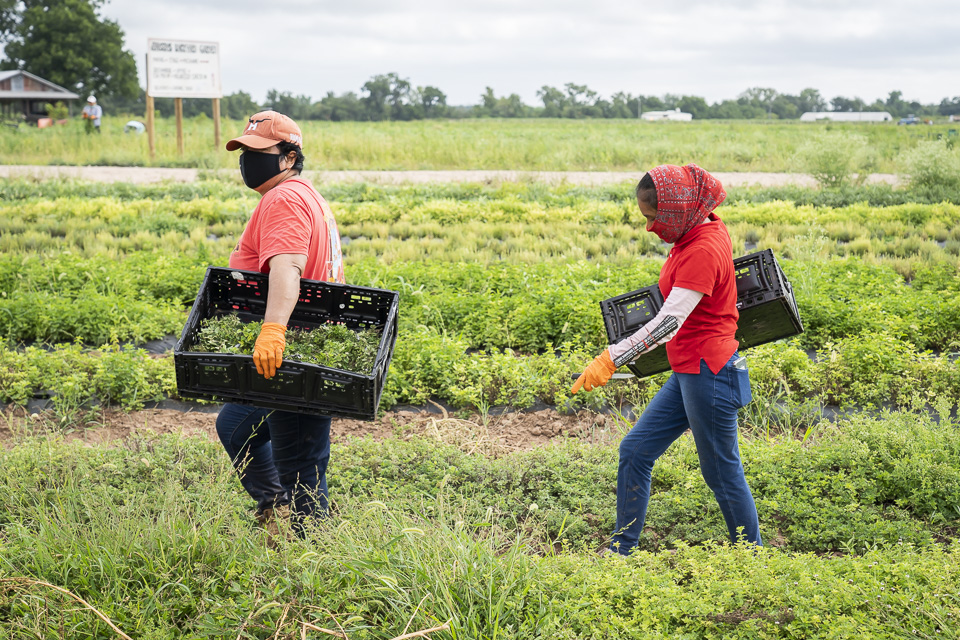 Bringing in the herbs. Photo by Scott David Gordon
Bringing in the herbs. Photo by Scott David Gordon
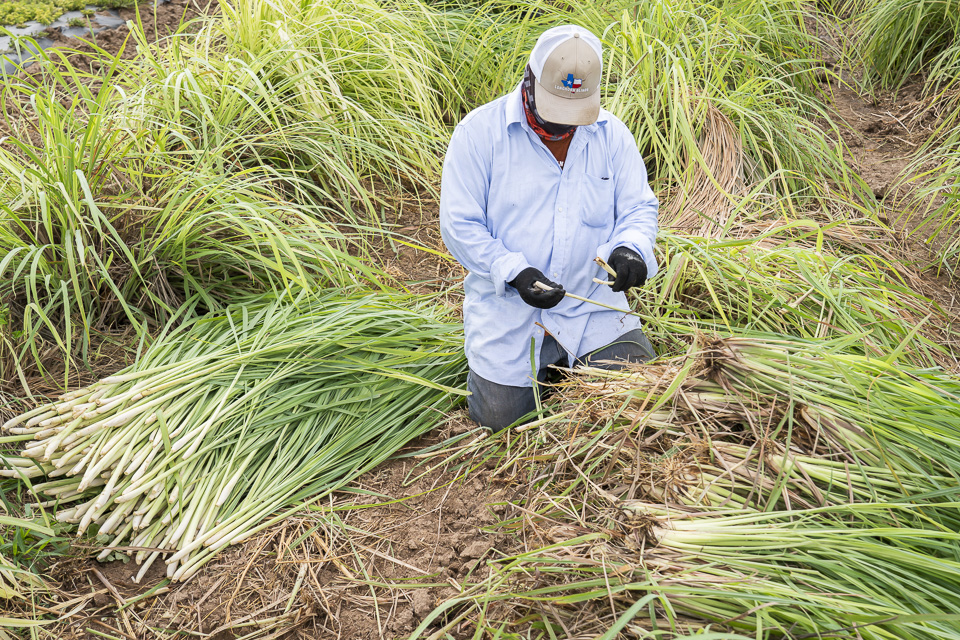 Lemongrass harvest. Photo by Scott David Gordon
Lemongrass harvest. Photo by Scott David Gordon
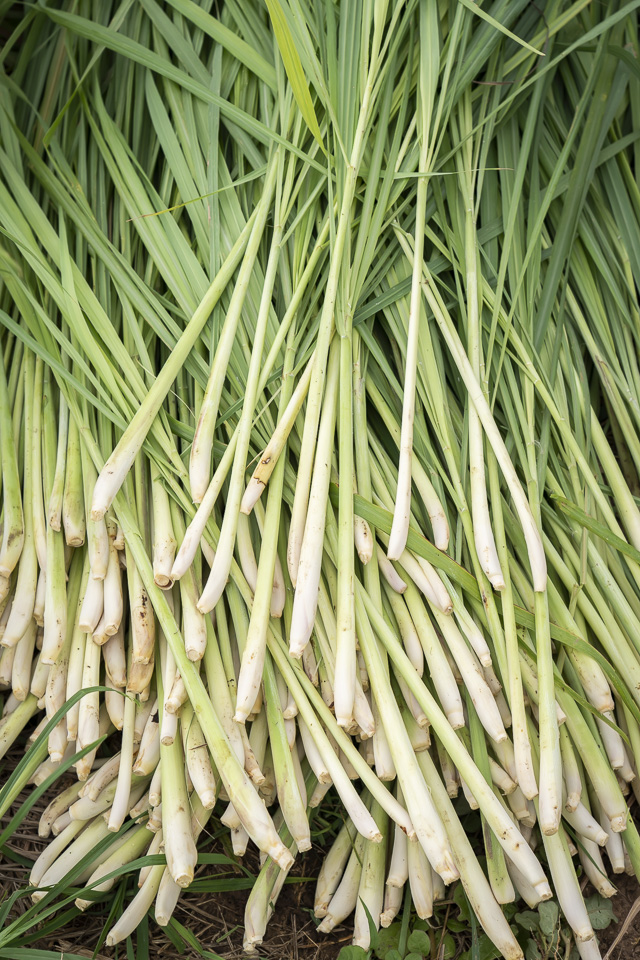 Lemongrass. Photo by Scott David Gordon
Lemongrass. Photo by Scott David Gordon
 New plantings, even as it gets hot! Photo by Scott David Gordon
New plantings, even as it gets hot! Photo by Scott David Gordon
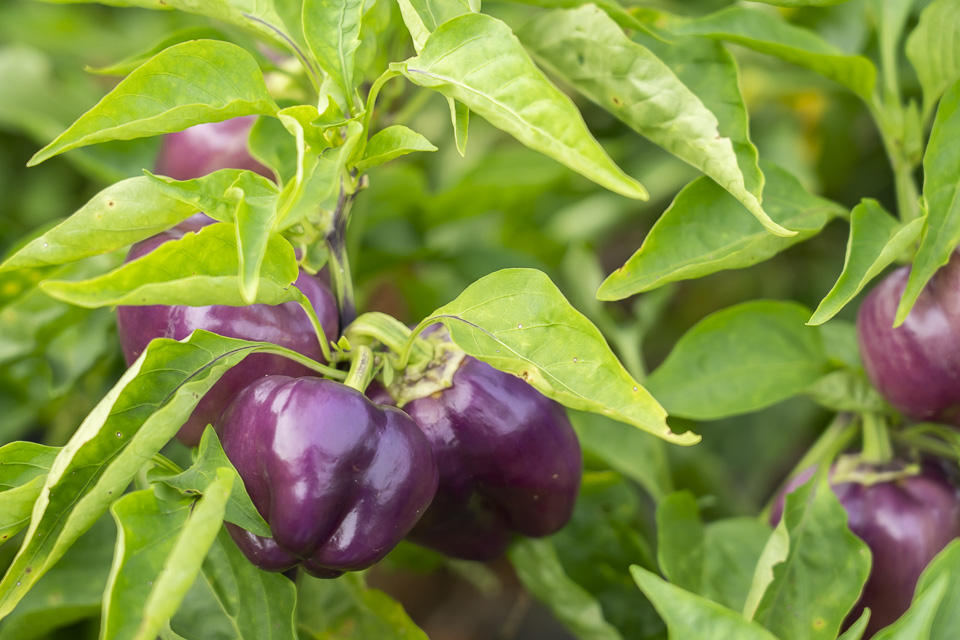 Purple bell peppers. Photo by Scott David Gordon
Purple bell peppers. Photo by Scott David Gordon
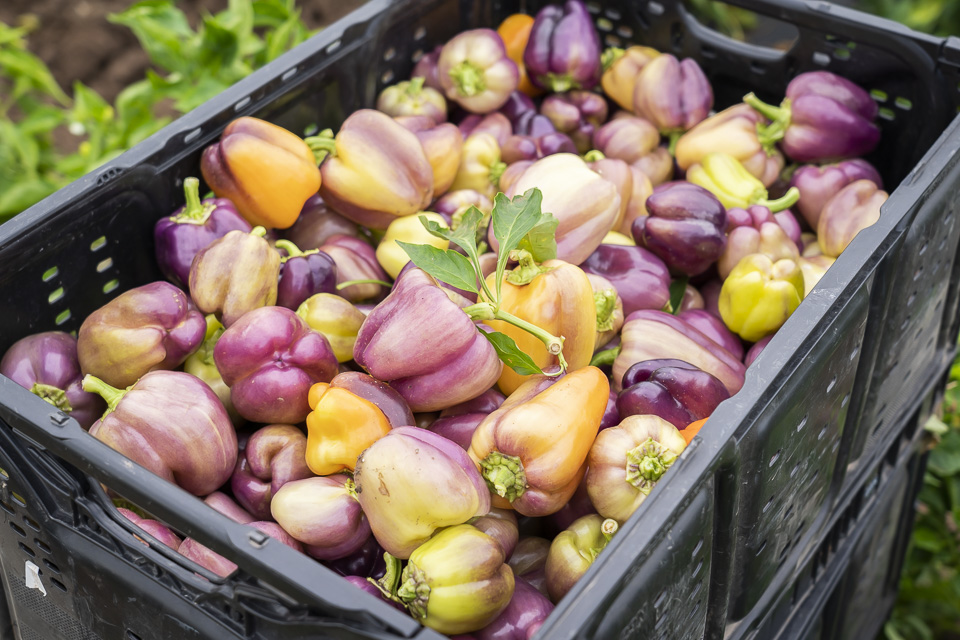 Bin of purple bells. Photo by Scott David Gordon
Bin of purple bells. Photo by Scott David Gordon
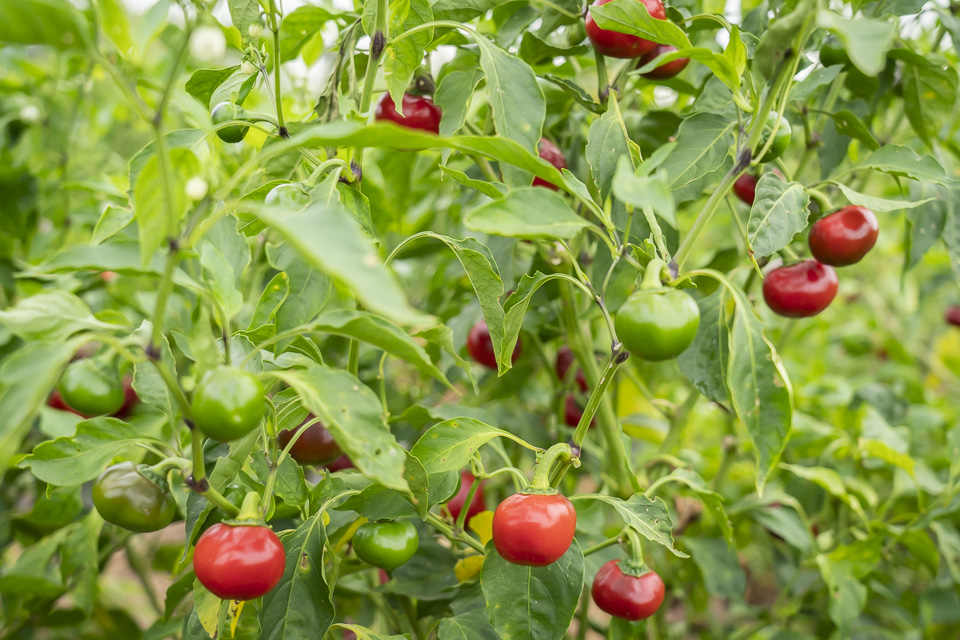 Hot cherry bomb peppers, with heat comparable to jalapenos. Photo by Scott David Gordon
Hot cherry bomb peppers, with heat comparable to jalapenos. Photo by Scott David GordonSUSTAINABLE FOOD CENTER: LOCAL FOOD FOR ALL
07/24/20 — Ada Broussard
Sustainable Food Center runs two farmers’ markets weekly, our flagship Downtown and neighborhood market at Sunset Valley.
The New Normal
Every Saturday morning around 5:30 trucks begin to ramble into Austin weighed down with hill country peaches, grass-fed beef, and locally grown veggies. Farmers and ranchers start setting up their booths before the sun peaks through the valleys of towering office buildings downtown, carefully arranging their wares to catch the eye of market customers. Alex Mace, SFC’s food access manager, helps to stack our new WIC Produce Boxes near the entrance to market and draws chalk lines 6 feet apart in front, anticipating the lines of people who are coming to pick up their veggie haul.
The ritual of creating a market from nothing has been happening since 2003 at Republic Square and 2008 at the Toney Burger Stadium although things look different this year than last. During COVID we have had to adjust to ensure the safety of our customers, vendors, and staff. Gone are the densely packed market stalls that scream out in abundance, and in their place are expanses of vendors donning masks and buffer tables between piles of produce and patient customers.![]()
In this season of pivots and pilot programs, perhaps the most innovative is this preorder option for food access programming. Historically clients must show up in person, shopping list and cards in hand for individual consultation to pick up WIC vouchers. Now clients can verify their eligibility online and schedule pick up times for pre-packed local food boxes from either market. This lessens the time folks must be in the market space and ensures quick moving, socially distanced encounters with staff. It also helps local farms, like Johnson’s Backyard Garden, who now have a guaranteed number of purchases through this program every week.
The Right to Healthy Food
Sustainable Food Center’s mission is to cultivate a just and regenerative food system so people and the environment can thrive. What this means is that we work closely with farmers in Central Texas to provide resources to help them preserve soil health, get business management training, and connect with buyers through our markets and connections with institutional purchasers. We work closely with policymakers to tell the stories of small farmers, advocating for programs that will help them strengthen their farms and communities. We work with the public to promote at home gardening and healthy eating with our nutrition classes (and new edition of our cookbook!) What really sets us apart is our belief that healthy food is for everyone.
![]()
Over 14% of Travis County Residents are food insecure and have had trouble meeting their food needs in the past year. Emergency hunger organizations across the country have been overwhelmed since the beginning of our current public health crisis, and while these organizations can help bridge the gap for many families, they do not work on systemic issues facing our food system. SFC is working to create a regenerative food system – where food is grown in our communities, the land is restored, and food is available to all people.
SFC has provided food access programming since 1995 through neighborhood farm stands and the launch of our Downtown market in 2003. SFC markets accept Lone Star/SNAP (Supplemental Nutrition Assistance Program - formerly known as food stamps), WIC (Women, Infants and Children) and FMNP (Farmers’ Market Nutrition Program) benefits at area Farmers’ Markets, Farm Stands, and partner sites throughout Austin helping people access local, fresh food for their families. These benefits are doubled through Double Up Food Bucks, matching up to $30 in SNAP, WIC, and FMNP benefits for the purchase of fruits and vegetables.
Every year in March we begin gearing up for the Farmers Market Nutrition Program. Clients love this seasonal benefit program that helps them take full advantage of the amazing array of spring and summer veggies available in Central Texas. However, this year was different. As markets faced potential shut downs, low attendance, vendors leaving the market and funding insecurity we chose to delay the beginning of FMNP season while we created a solution that mitigated long lines and availability of produce.
This is where the WIC boxes come in. Clients can now pre-order a $30 box of produce from farms like JBG, Lightsey Farm, and Urban Roots for pickup at either of our markets. WIC eligible clients can order a box online, or call to talk to one of our promotoras through our help desk to place an order. So far, we have distributed 220 boxes, or 3,300 lbs. of food!
Friendly Neighborhood Farmer
We are all shifting our lifestyles, our expectations, and the way we nourish ourselves. SFC is adapting and moving online, to preorders for low income families and everyone through our new Neighborhood Pop Up Grocery project, supporting Farmshare and their Fresh for Less produce delivery, and working at all costs to keep markets open and safe for all. Throughout this, JBG has been a stalwart partner and resource for the community.
![]() Farmer Brenton in the early days of the Downtown Farmers' Market.
Farmer Brenton in the early days of the Downtown Farmers' Market.
The New Normal
Every Saturday morning around 5:30 trucks begin to ramble into Austin weighed down with hill country peaches, grass-fed beef, and locally grown veggies. Farmers and ranchers start setting up their booths before the sun peaks through the valleys of towering office buildings downtown, carefully arranging their wares to catch the eye of market customers. Alex Mace, SFC’s food access manager, helps to stack our new WIC Produce Boxes near the entrance to market and draws chalk lines 6 feet apart in front, anticipating the lines of people who are coming to pick up their veggie haul.
The ritual of creating a market from nothing has been happening since 2003 at Republic Square and 2008 at the Toney Burger Stadium although things look different this year than last. During COVID we have had to adjust to ensure the safety of our customers, vendors, and staff. Gone are the densely packed market stalls that scream out in abundance, and in their place are expanses of vendors donning masks and buffer tables between piles of produce and patient customers.
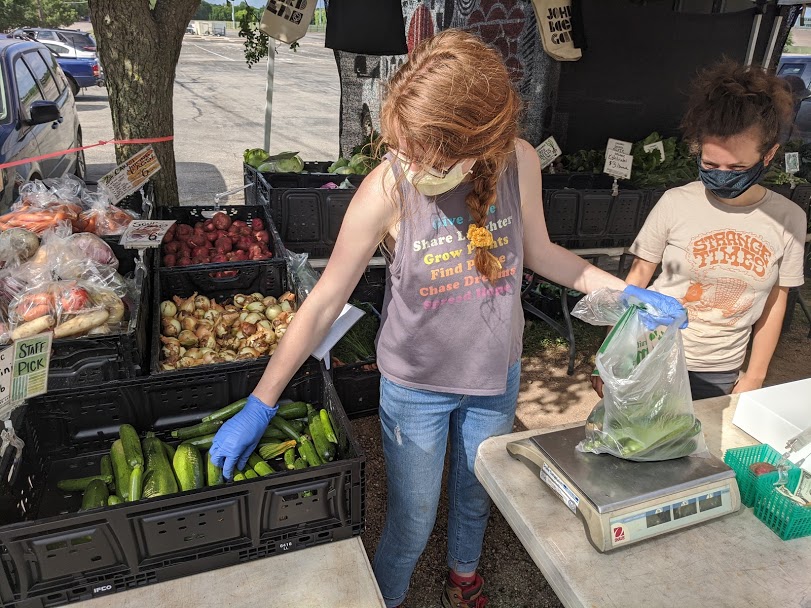
In this season of pivots and pilot programs, perhaps the most innovative is this preorder option for food access programming. Historically clients must show up in person, shopping list and cards in hand for individual consultation to pick up WIC vouchers. Now clients can verify their eligibility online and schedule pick up times for pre-packed local food boxes from either market. This lessens the time folks must be in the market space and ensures quick moving, socially distanced encounters with staff. It also helps local farms, like Johnson’s Backyard Garden, who now have a guaranteed number of purchases through this program every week.
The Right to Healthy Food
Sustainable Food Center’s mission is to cultivate a just and regenerative food system so people and the environment can thrive. What this means is that we work closely with farmers in Central Texas to provide resources to help them preserve soil health, get business management training, and connect with buyers through our markets and connections with institutional purchasers. We work closely with policymakers to tell the stories of small farmers, advocating for programs that will help them strengthen their farms and communities. We work with the public to promote at home gardening and healthy eating with our nutrition classes (and new edition of our cookbook!) What really sets us apart is our belief that healthy food is for everyone.
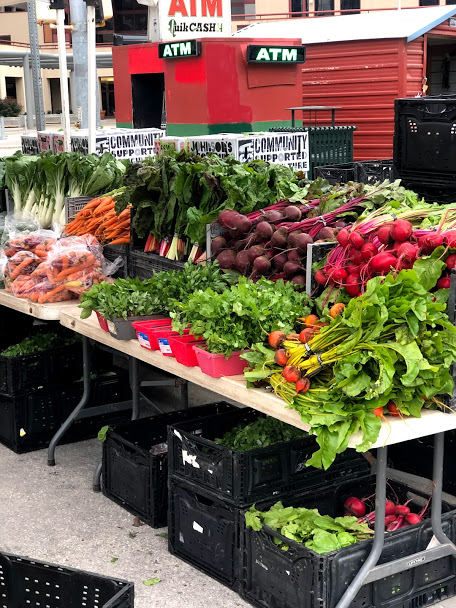
Over 14% of Travis County Residents are food insecure and have had trouble meeting their food needs in the past year. Emergency hunger organizations across the country have been overwhelmed since the beginning of our current public health crisis, and while these organizations can help bridge the gap for many families, they do not work on systemic issues facing our food system. SFC is working to create a regenerative food system – where food is grown in our communities, the land is restored, and food is available to all people.
SFC has provided food access programming since 1995 through neighborhood farm stands and the launch of our Downtown market in 2003. SFC markets accept Lone Star/SNAP (Supplemental Nutrition Assistance Program - formerly known as food stamps), WIC (Women, Infants and Children) and FMNP (Farmers’ Market Nutrition Program) benefits at area Farmers’ Markets, Farm Stands, and partner sites throughout Austin helping people access local, fresh food for their families. These benefits are doubled through Double Up Food Bucks, matching up to $30 in SNAP, WIC, and FMNP benefits for the purchase of fruits and vegetables.
Every year in March we begin gearing up for the Farmers Market Nutrition Program. Clients love this seasonal benefit program that helps them take full advantage of the amazing array of spring and summer veggies available in Central Texas. However, this year was different. As markets faced potential shut downs, low attendance, vendors leaving the market and funding insecurity we chose to delay the beginning of FMNP season while we created a solution that mitigated long lines and availability of produce.
This is where the WIC boxes come in. Clients can now pre-order a $30 box of produce from farms like JBG, Lightsey Farm, and Urban Roots for pickup at either of our markets. WIC eligible clients can order a box online, or call to talk to one of our promotoras through our help desk to place an order. So far, we have distributed 220 boxes, or 3,300 lbs. of food!
Friendly Neighborhood Farmer
We are all shifting our lifestyles, our expectations, and the way we nourish ourselves. SFC is adapting and moving online, to preorders for low income families and everyone through our new Neighborhood Pop Up Grocery project, supporting Farmshare and their Fresh for Less produce delivery, and working at all costs to keep markets open and safe for all. Throughout this, JBG has been a stalwart partner and resource for the community.
 Farmer Brenton in the early days of the Downtown Farmers' Market.
Farmer Brenton in the early days of the Downtown Farmers' Market.
CSA BOX CONTENTS WEEK OF JULY 27TH
07/27/20 — Scott
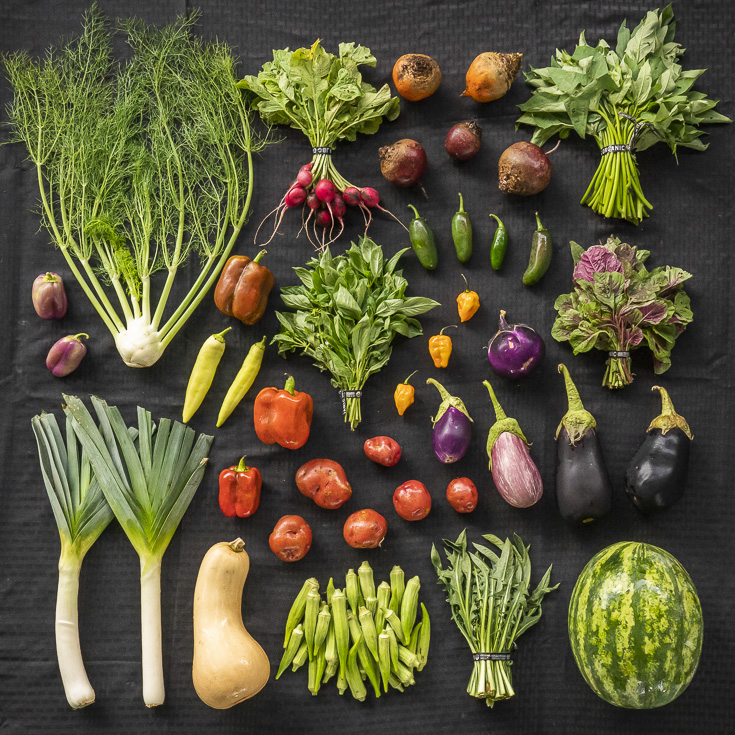 CSA Box Contents Week of July 27th
CSA Box Contents Week of July 27th
Large Box
Beets
Eggplant
Greens, Dandelion
Greens, Sweet Potato
Herb, Basil
Herb, Fennel
Melon, Farmers Choice
Okra
Pepper, Sweet Medley
Potato
Radish
Winter Squash
Beets
Eggplant
Greens, Dandelion
Greens, Sweet Potato
Herb, Basil
Herb, Fennel
Melon, Farmers Choice
Okra
Pepper, Sweet Medley
Potato
Radish
Winter Squash
Medium Box
Beets
Farmers Choice
Herb, Basil
Leek
Melon, Farmers Choice
Okra
Pepper, Sweet Medley
Potato
Squash, Farmer's Choice
Winter Squash
Beets
Farmers Choice
Herb, Basil
Leek
Melon, Farmers Choice
Okra
Pepper, Sweet Medley
Potato
Squash, Farmer's Choice
Winter Squash
Small Box
Eggplant
Farmers Choice
Herb, Basil
Leek
Pepper, Sweet Medley
Potato
Squash, Farmer's Choice
Eggplant
Farmers Choice
Herb, Basil
Leek
Pepper, Sweet Medley
Potato
Squash, Farmer's Choice
Individual Box
Beets
Eggplant
Okra
Pepper, Sweet Medley
Winter Squash
Beets
Eggplant
Okra
Pepper, Sweet Medley
Winter Squash
CSA BOX CONTENTS WEEK OF JULY 27TH
07/28/20 — Scott
 CSA Box Contents Week of July 27th
CSA Box Contents Week of July 27th
Large Box
Beets
Eggplant
Greens, Dandelion
Greens, Sweet Potato
Herb, Basil
Herb, Fennel
Melon, Farmers Choice
Okra
Pepper, Sweet Medley
Potato
Radish
Winter Squash
WATERMELON RIND CURRY
07/29/20 — Ada Broussard
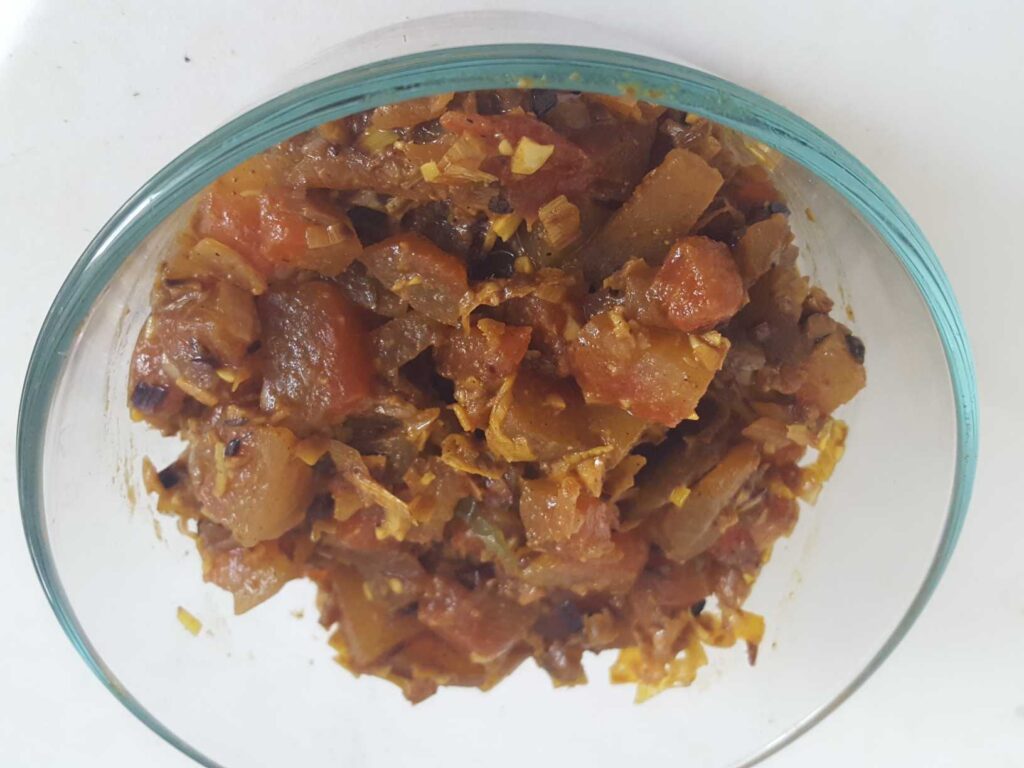 Watermelon rind curry.
Watermelon rind curry.
Recipe and photos by Agatha B.
When one of our CSA Members, Agatha, emailed the farm with this recipe, we knew we had to share. It's just too weird, and unique, not to. The best part? After e-mailing us her watermelon rind curry recipe, Agatha sent over her watermelon rind pickle recipe! Scroll to the bottom of this post for pickle. Thank you Agatha, for your kind words about our veggies, and also for these amazingly creative recipes!
Hey lovely farmers, I wanted to thank you for the beautiful food and to celebrate watermelon. I'm not sure if we're getting more-- but if we do, I'm definitely making more of this curry.
much appreciation, Agatha
p.s. The recipe is also easy to cut in half-- which is what I did because I'd turned the rest into refrigerator pickles.)
WATERMELON RIND CURRY
- 4-5 c. watermelon rind with the dark green exterior removed, chopped into about 1/4 – 1/2 inch pieces
- 1/2 c. finely chopped onions and/or leeks (soft white part of leeks)
- 1 T. oil
- 1/2 t. cumin seeds
- 6 medium cloves garlic, minced
- 1 T. ginger, minced
- 1/2 serrano pepper, seeds removed, minced
- 1 t. paprika
- 1 t. coriander powder
- 1/2 t. amchur (dried green mango powder; this is optional. Sub a squeeze of lemon juice if amchur is unavailable)
- 1/4 t. turmeric powder
- 1/2 t. salt
- 1/4 c. water (more, if needed)
- 1/4 t. garam masala
Heat oil in a pot or 12-inch cast iron pan. When the oil is hot, add cumin seeds. When they sizzle and/or pop, add onion/leeks. Cook on low heat for about 5 minutes, stirring regularly, until the soften and begin to brown. Add garlic, ginger, and pepper and cook for another 1-2 minutes, stirring frequently.
Add paprika, coriander powder, amchur, turmeric, and salt. And stir until the onions, leeks, and garlic are coated. Add watermelon and water; mix well.
Cook covered for about 10-12 minutes total, stirring 3-4 times. If the water evaporates and the curry starts sticking, add a little more water.
When the rind is soft and most of the water is absorbed, and add the garam masala. Mix well and cook with the lid removed for another couple minutes.
Serve as a side dish with flatbread or over a grain like rice. The flavors only get better after a few days!
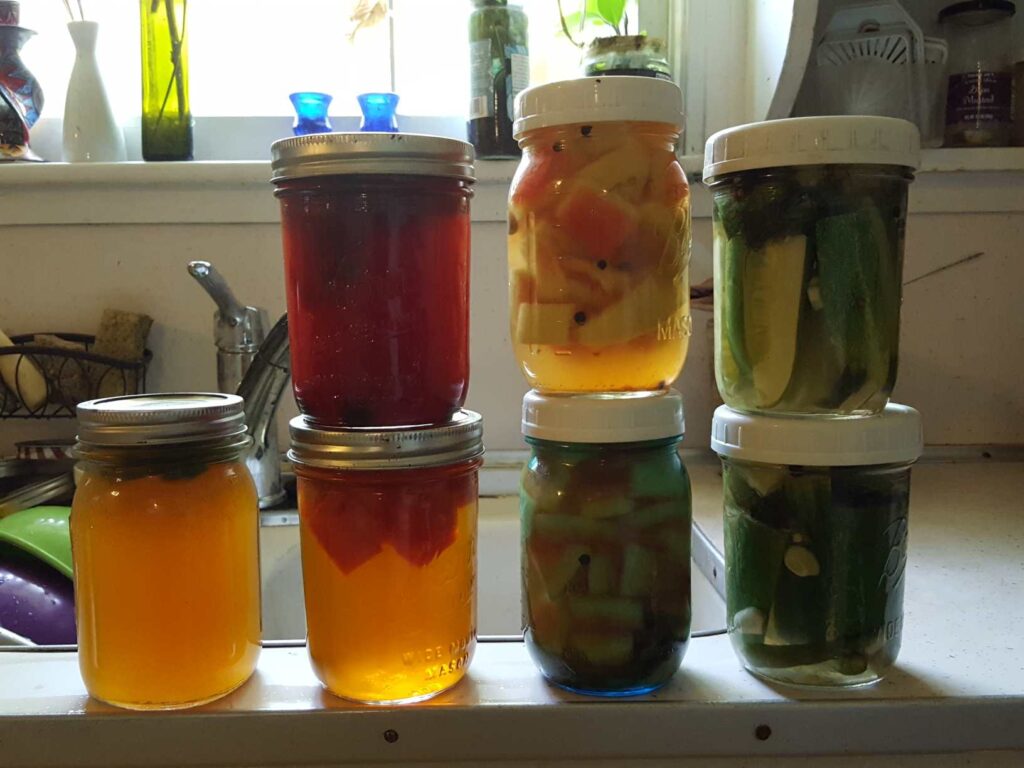 Watermelon rind and cucumber pickles by Agatha!
Watermelon rind and cucumber pickles by Agatha!
SWEET WATERMELON RIND PICKLE
- enough peeled and cubed watermelon chunks to fill a pint-sized mason jar + a small handful of extra pieces (the pieces of rind shrink a little after sitting in the warm brine)
- 1/2 c. water
- 1/2 c. cider vinegar
- 1-2 T. sugar (depends on your taste)
- 2 t. salt
- 1 T. ginger (about 1”) in slices
- 3 cardamom pods
- 1/4 t. black peppercorns
Scoop/slice out melon leaving about 1/4-1/2 inch of red flesh.
Peel off outer dark green skin with vegetable peeler and then cut rind into about 1-inch cubes.
Bring the vinegar, water, sugar, ginger, salt and spices to a boil over medium-high heat in a small saucepan (2-quart). Hold the boil for 60 seconds then carefully add the watermelon. Return to a boil and turn off the heat. Remove the pan from the heat and cool for 30 minutes.
Put the rind in the mason jar with the cardamom, pepper, and ginger. Pour on as much of the pickling juice as possible. Seal the jar and leave at room temperature for another one and half hours. Store in the refrigerator.
THE MERITS OF SWEET PEPPERS
07/31/20 — Ada Broussard
If you’re a CSA Member, you likely noticed the colorful assortment of sweet peppers scattered throughout your CSA box this week. We grow over 20 different varieties of peppers here at JBG, but this week we’re talking about those whose cell walls pack a sucrosey punch. Sweet peppers, members of the Capsicum family, can be crunched raw, like an apple, or incorporated into cooked dishes, providing a curtain of candy-like caramelization sweetening every bite. Peppers of all varieties are measured by Scoville heat units or SHUs. Hot peppers like jalapeños (2500-8000 SHUs) and habaneros (100,000-350,000 SHUs) aren’t the crop we care about today, and instead we’re just talking about the sweeties that adorn our fields: bell peppers (0-100 SHUs), banana peppers (1-500 SHU) and red and yellow Italian sweet peppers (0-500).
![]()
Sweet peppers are special not only because they are...sweet… but also because they survived the summer, despite the odds. You see, sweet peppers (often yellow, red, or orange in color) all start off as green. Green bell peppers, for example, are just the early, young, version of their red and yellow successors. It’s easy to harvest a pepper when it’s green - it hasn’t spent much time on the plant, and has thus avoided sun and pest damage. It’s more economical for farmers’ to harvest peppers early because each day the fruit sits on the plant, the more labor it takes to tend to the crop. But, what would a southern summer be without sweet peppers?
It may seem like we’re overloading you with sweet peppers this week, but we’re working off the assumption that there’s no such thing as too much of a good thing. Surplus peppers can be diced, blanched, and frozen or roasted, peeled, and packed in olive oil. Your future self will thank you for the prep work and warm, sweet flavors ready to enhance any fall feast or winter stew.
![]()
HOW TO STORE: Store unwashed sweet (and spicy, if you’re wondering) peppers in a plastic bag, in the refrigerator. Wait to wash the peppers just before you’re going to use them. Peppers stored this way should last for at least 1 week, potentially longer if they’re green. Keeping peppers in a bag, in the fridge, will help keep the moisture in the pepper and prolong the crunch-factor. Green peppers will usually last a bit longer than red or yellow ones, so save the green ones for later and use the others first!
HOW TO COOK: Stuff em’, saute them, eat them raw dipped in hummus, or roast them slow. The ways to eat sweet peppers are truly endless; incorporating sweet peppers into your cooking is a simple way to add (natural) sugar to your dish, which, spoiler alert: make everything taste a little more delicious. Use sweet peppers as a background ingredient (for example: as a part of the Holy Trinity as seen in Creole and Cajun cuisine or the base of a stirfry) or highlight peppers as an all-star: pitted and then stuffed with cheese, or rice, or cheesy rice.
HOW TO PRESERVE: Peter Piper picked a peck of pickled peppers, and you can definitely do the same. Peppers can also be blanched and frozen, but can also be slowly cooked in olive oil and packed into jars. Sweet peppers can be made into a sweet jam, and then schmeared on crackers with a healthy dose of cream cheese. Make a double batch of salsa or tomato sauce with some of your sweet peppers, some now, and some for later.
![]()
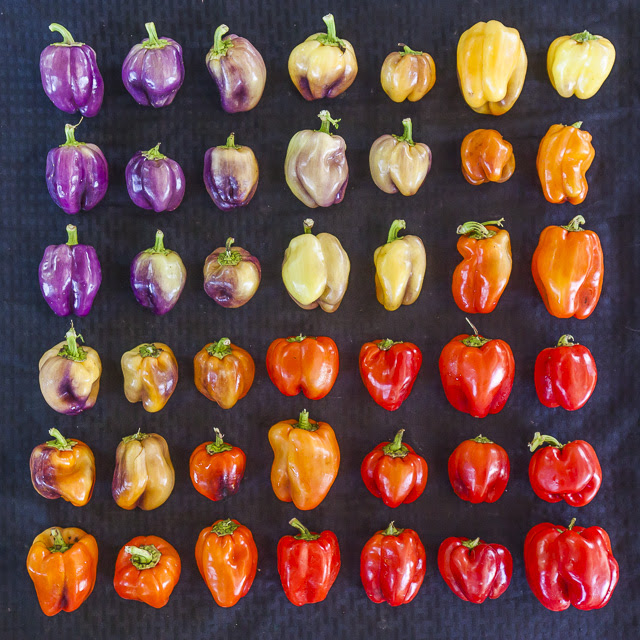
Sweet peppers are special not only because they are...sweet… but also because they survived the summer, despite the odds. You see, sweet peppers (often yellow, red, or orange in color) all start off as green. Green bell peppers, for example, are just the early, young, version of their red and yellow successors. It’s easy to harvest a pepper when it’s green - it hasn’t spent much time on the plant, and has thus avoided sun and pest damage. It’s more economical for farmers’ to harvest peppers early because each day the fruit sits on the plant, the more labor it takes to tend to the crop. But, what would a southern summer be without sweet peppers?
It may seem like we’re overloading you with sweet peppers this week, but we’re working off the assumption that there’s no such thing as too much of a good thing. Surplus peppers can be diced, blanched, and frozen or roasted, peeled, and packed in olive oil. Your future self will thank you for the prep work and warm, sweet flavors ready to enhance any fall feast or winter stew.
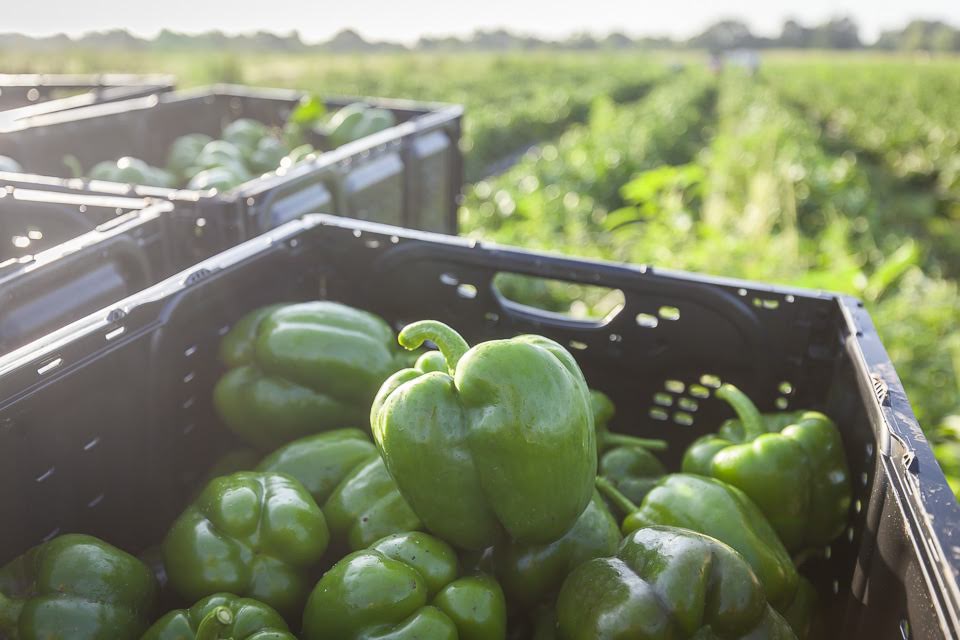
HOW TO STORE: Store unwashed sweet (and spicy, if you’re wondering) peppers in a plastic bag, in the refrigerator. Wait to wash the peppers just before you’re going to use them. Peppers stored this way should last for at least 1 week, potentially longer if they’re green. Keeping peppers in a bag, in the fridge, will help keep the moisture in the pepper and prolong the crunch-factor. Green peppers will usually last a bit longer than red or yellow ones, so save the green ones for later and use the others first!
HOW TO COOK: Stuff em’, saute them, eat them raw dipped in hummus, or roast them slow. The ways to eat sweet peppers are truly endless; incorporating sweet peppers into your cooking is a simple way to add (natural) sugar to your dish, which, spoiler alert: make everything taste a little more delicious. Use sweet peppers as a background ingredient (for example: as a part of the Holy Trinity as seen in Creole and Cajun cuisine or the base of a stirfry) or highlight peppers as an all-star: pitted and then stuffed with cheese, or rice, or cheesy rice.
HOW TO PRESERVE: Peter Piper picked a peck of pickled peppers, and you can definitely do the same. Peppers can also be blanched and frozen, but can also be slowly cooked in olive oil and packed into jars. Sweet peppers can be made into a sweet jam, and then schmeared on crackers with a healthy dose of cream cheese. Make a double batch of salsa or tomato sauce with some of your sweet peppers, some now, and some for later.
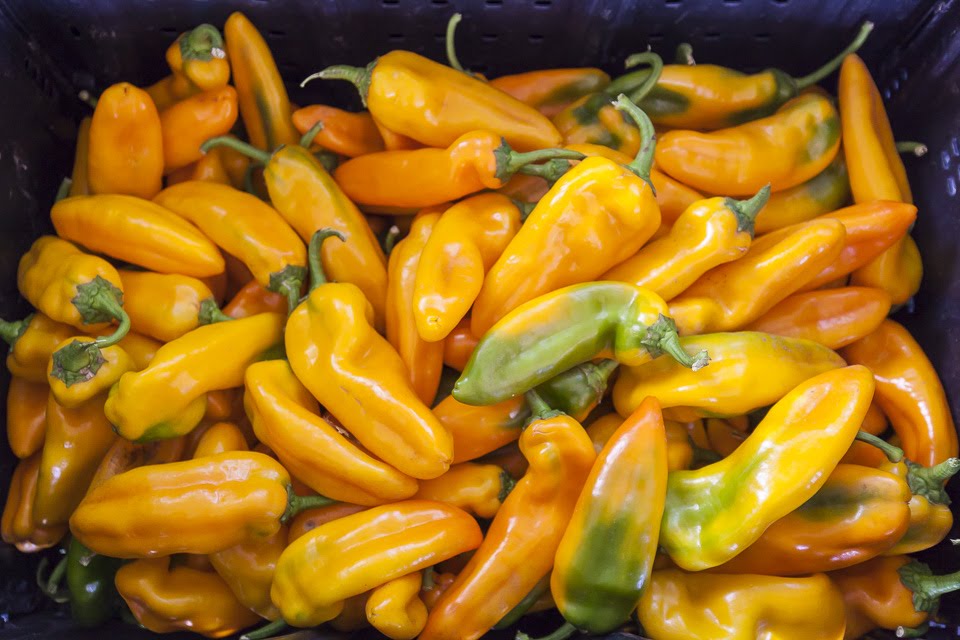






 0 ITEMS IN CART
0 ITEMS IN CART 

